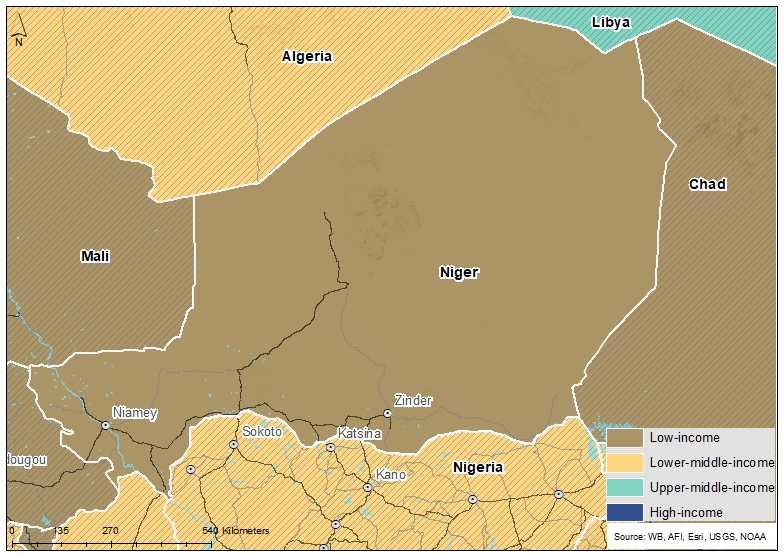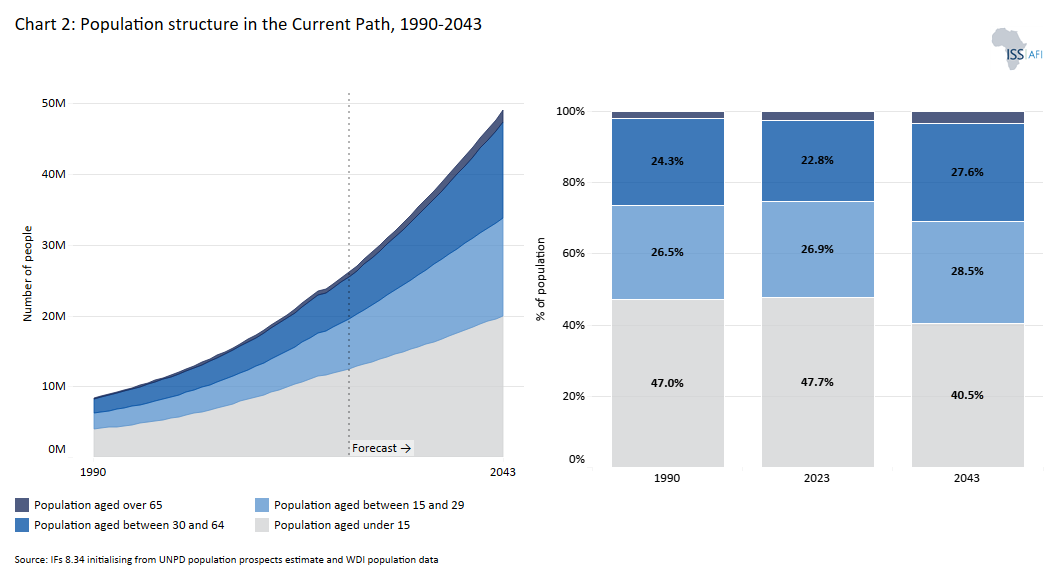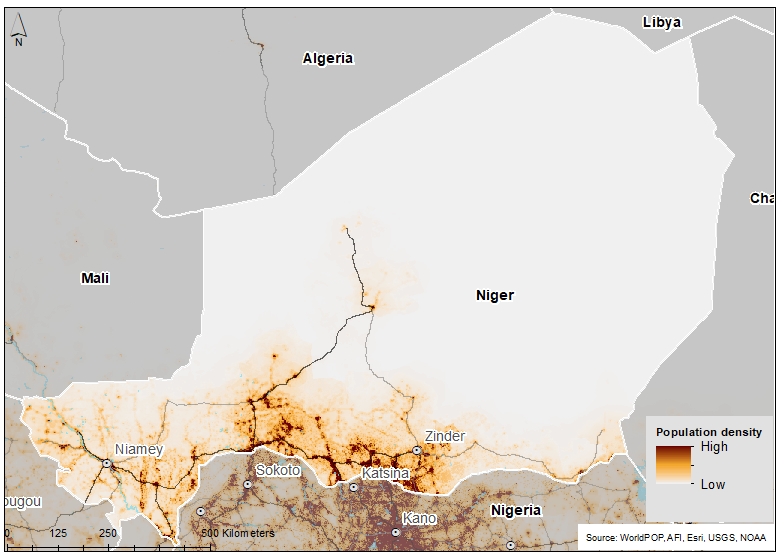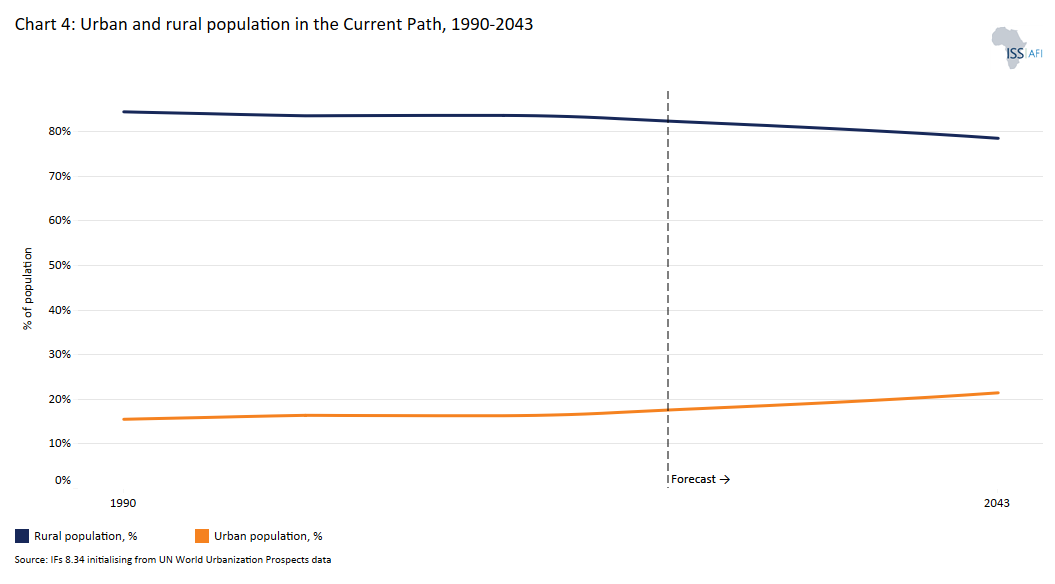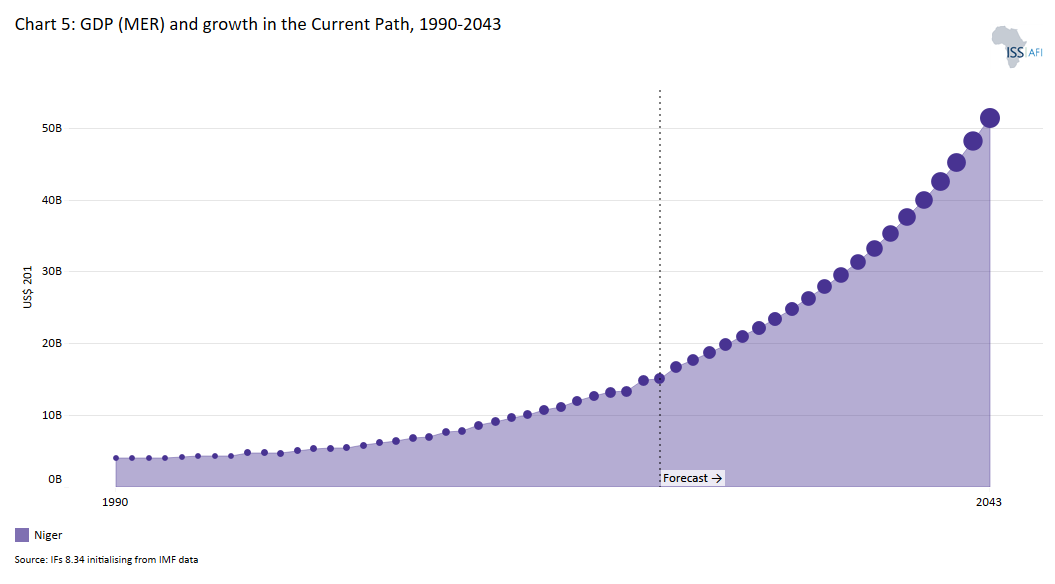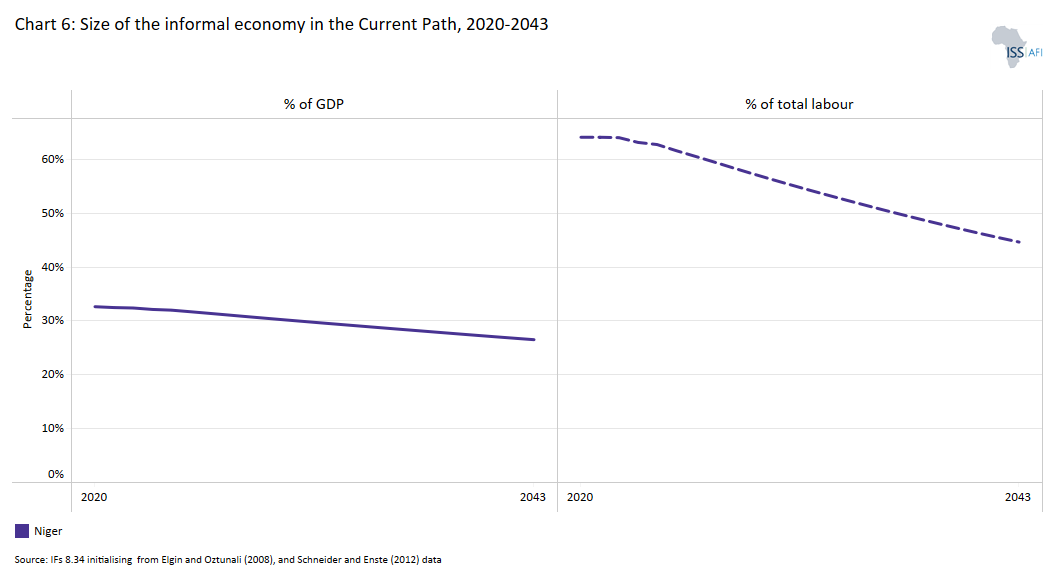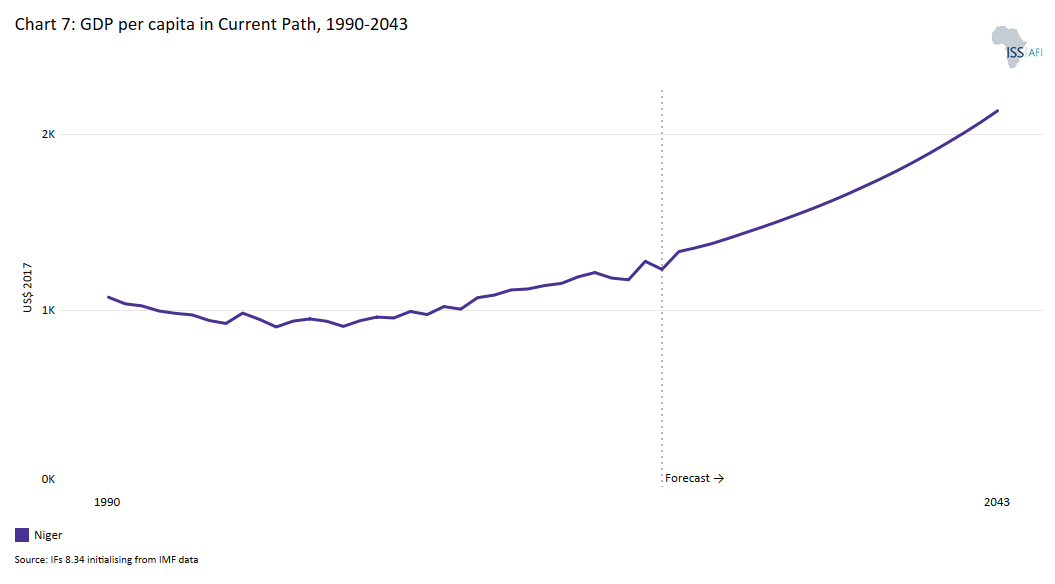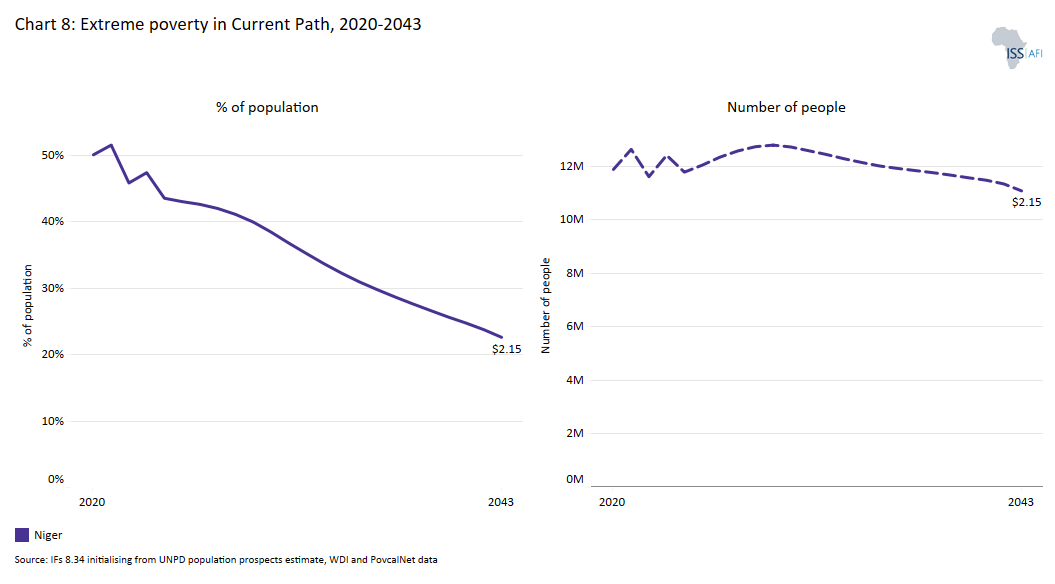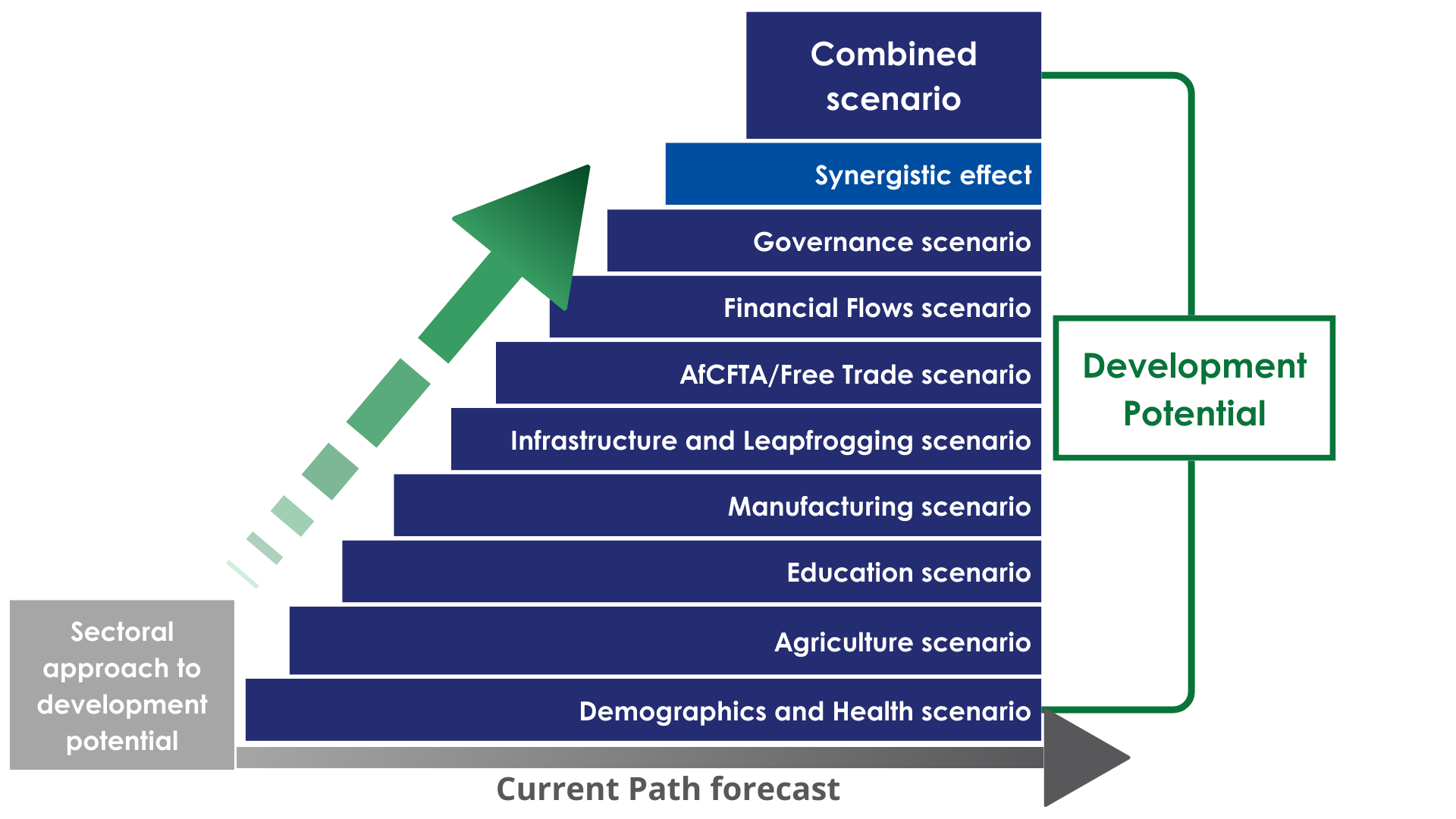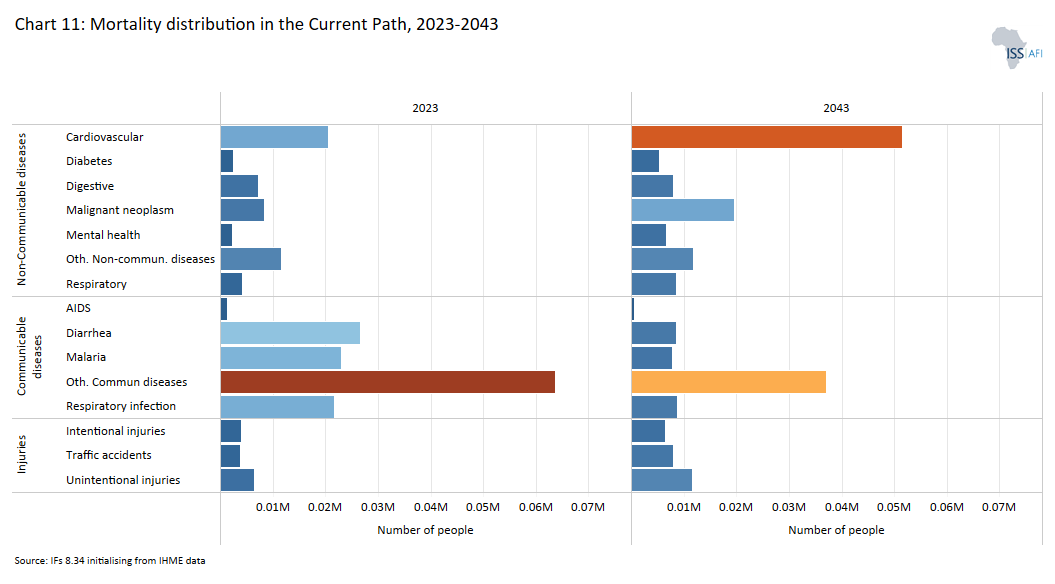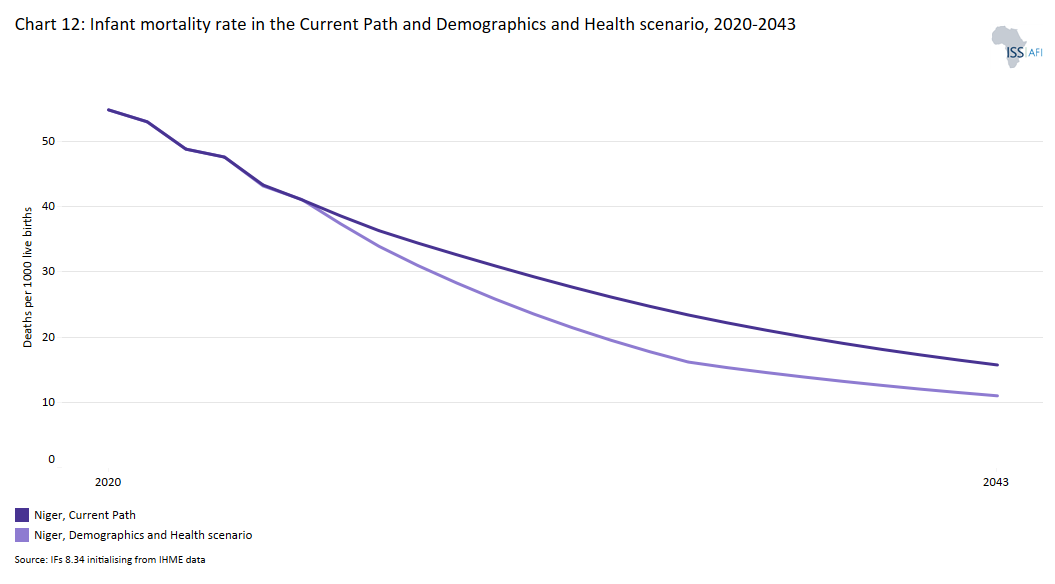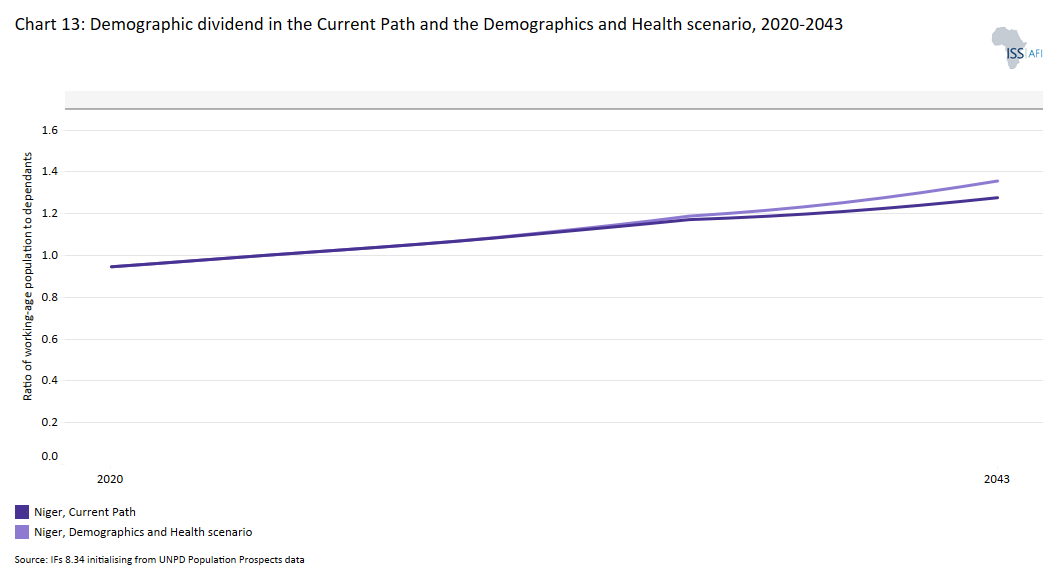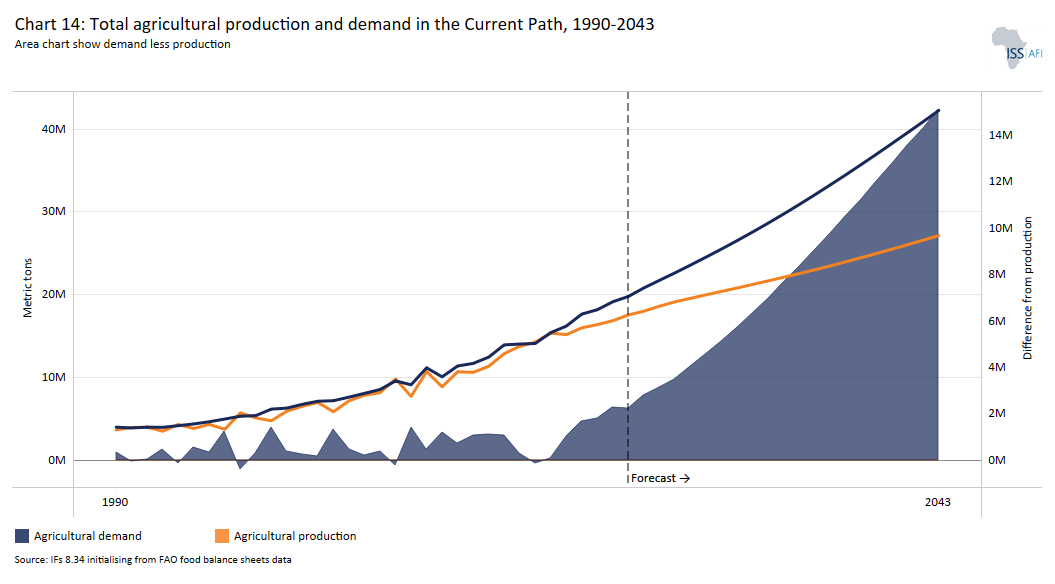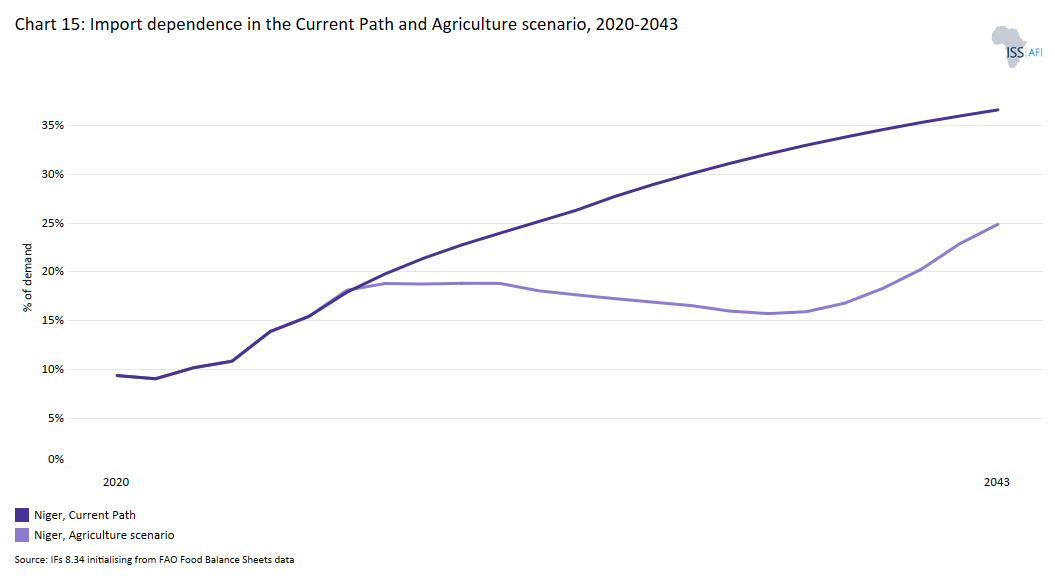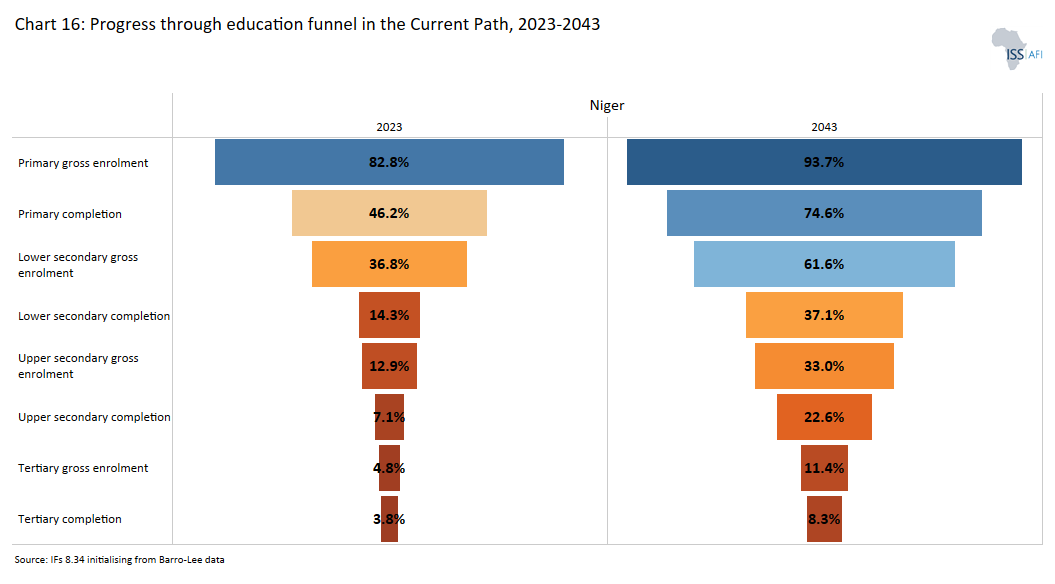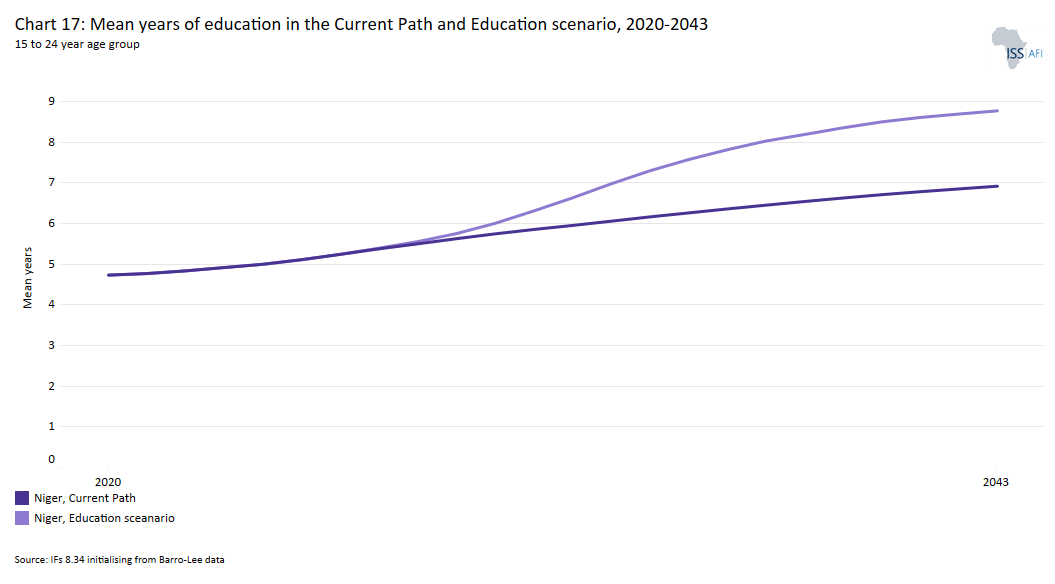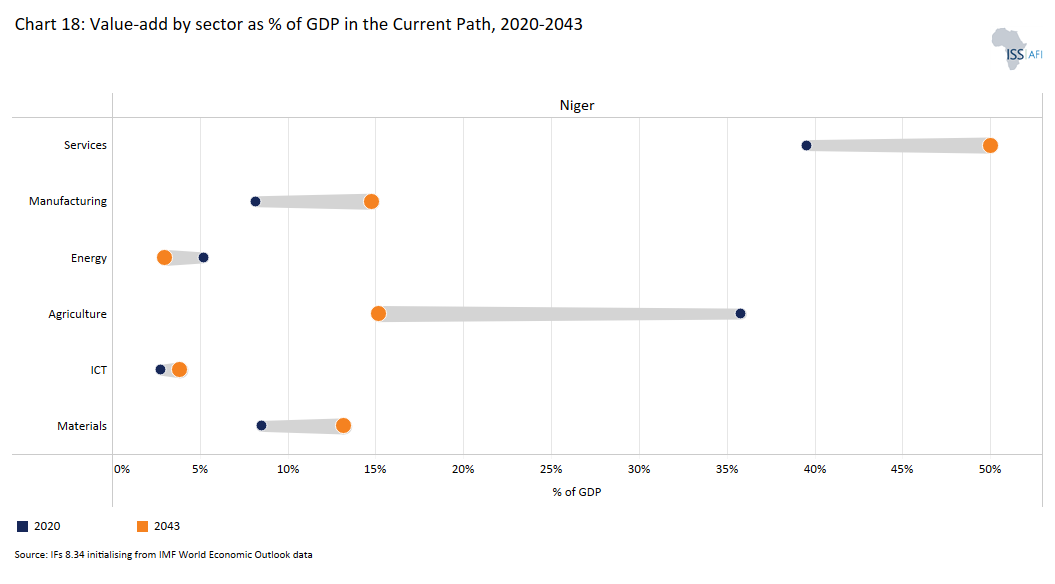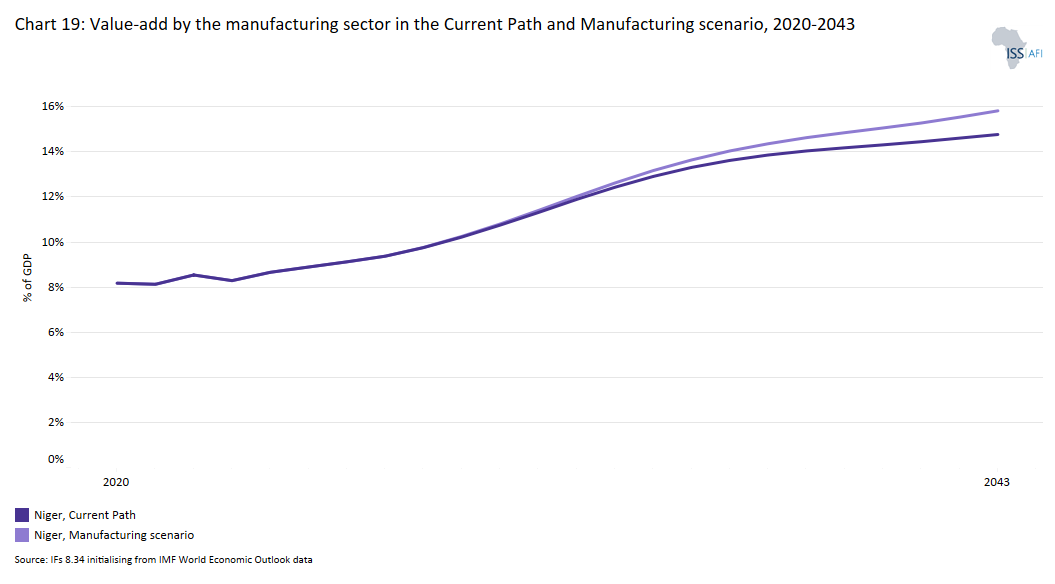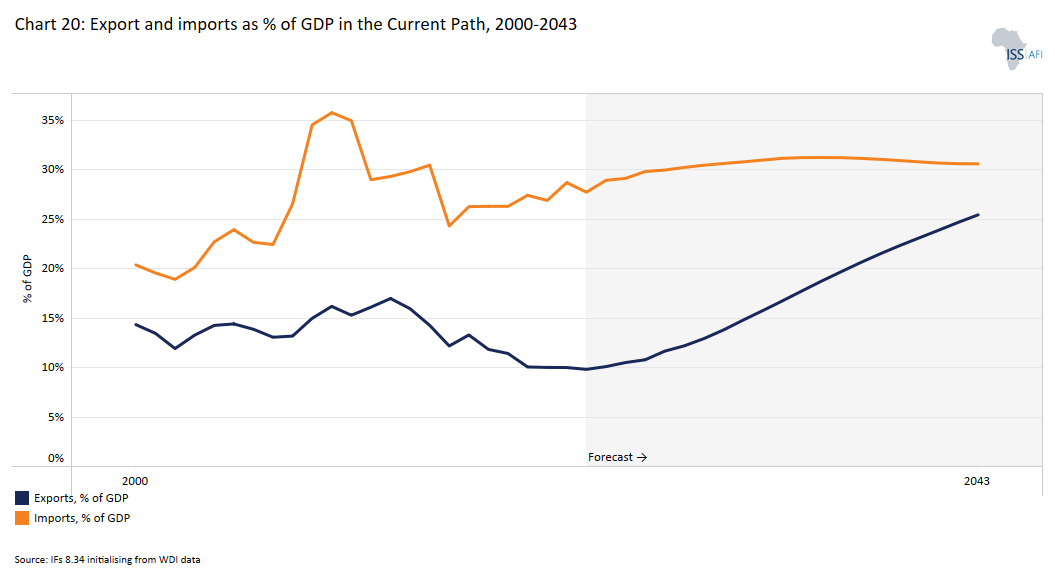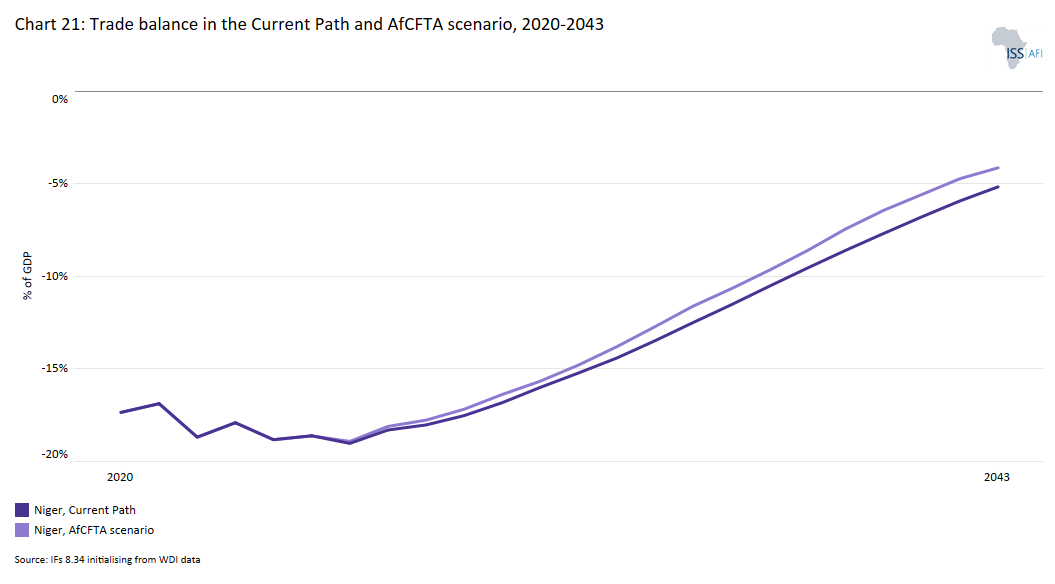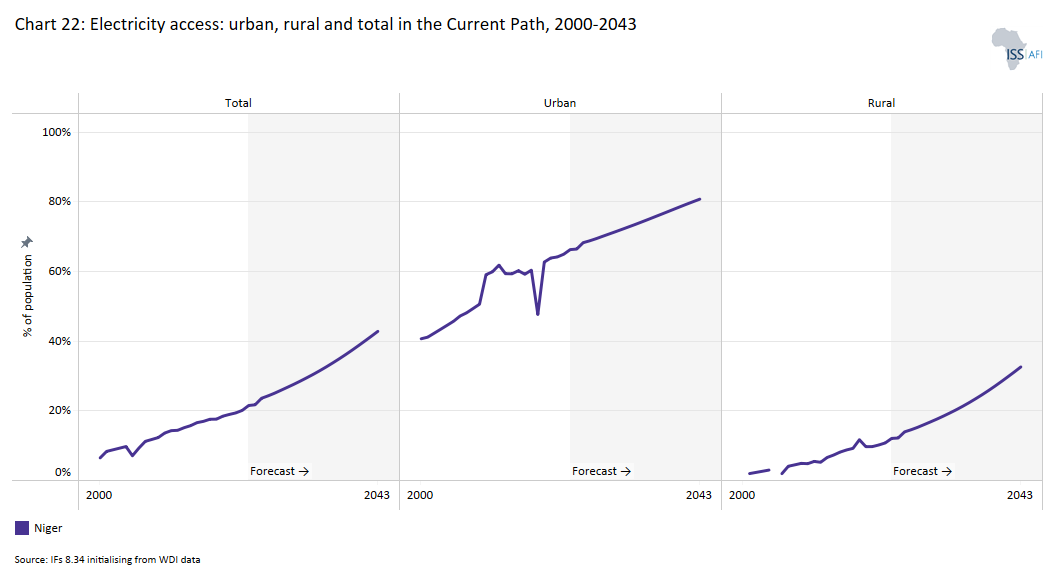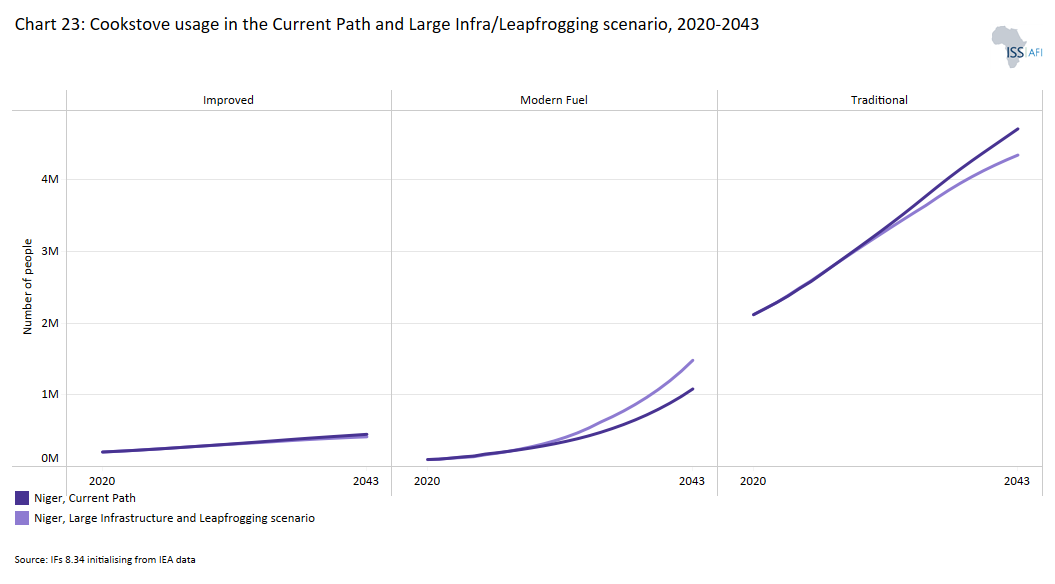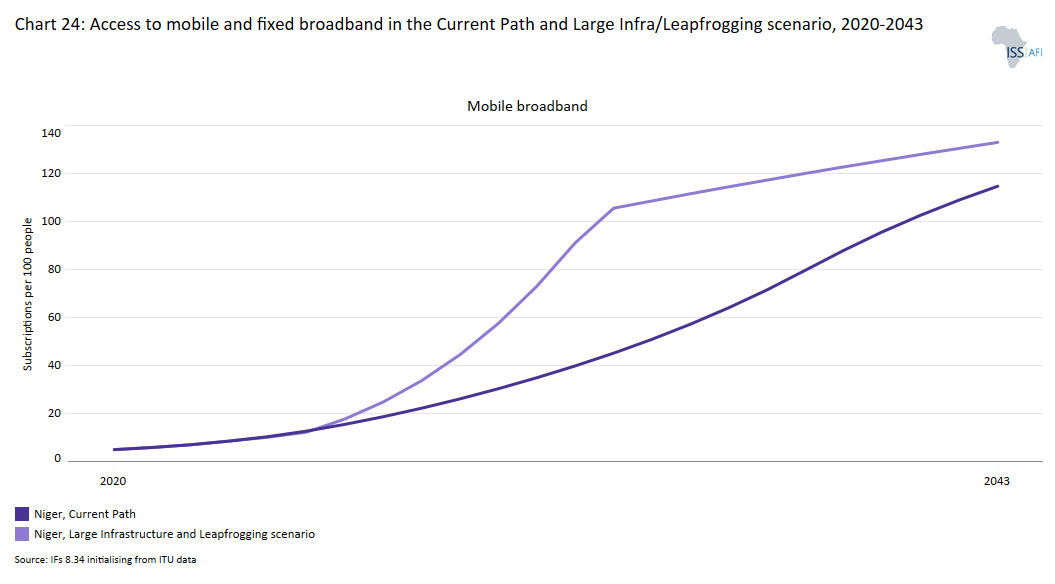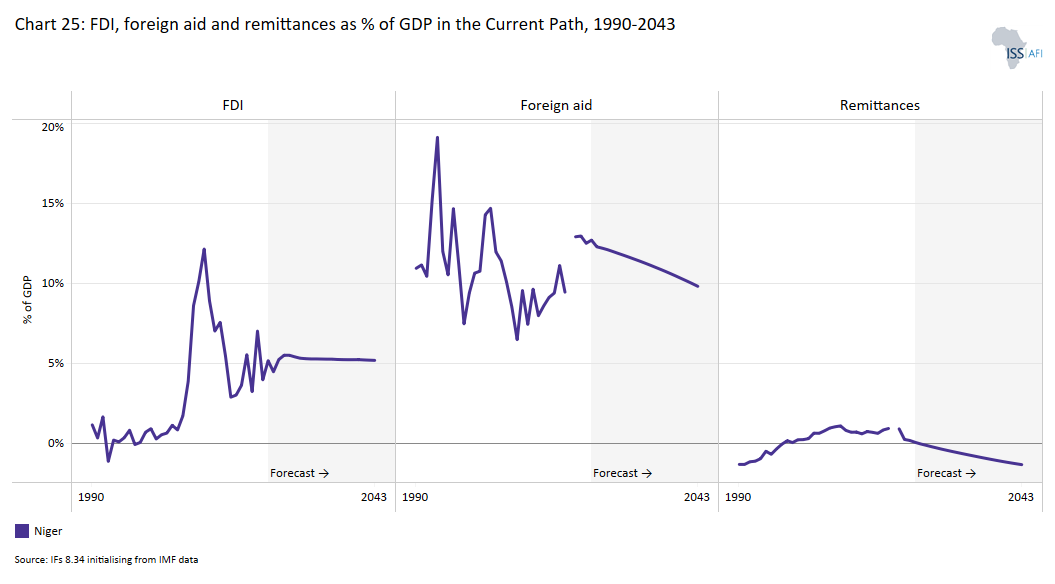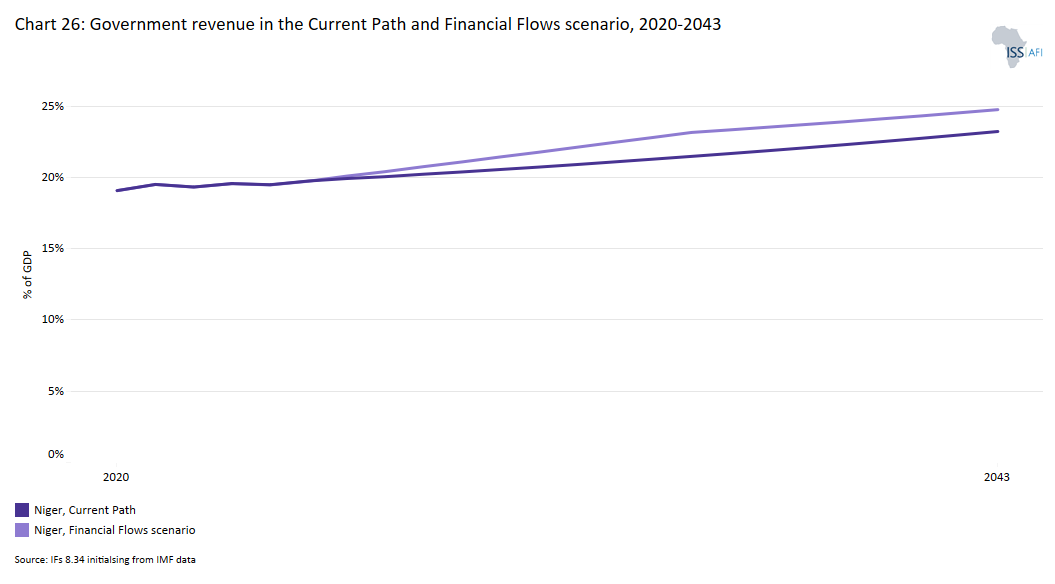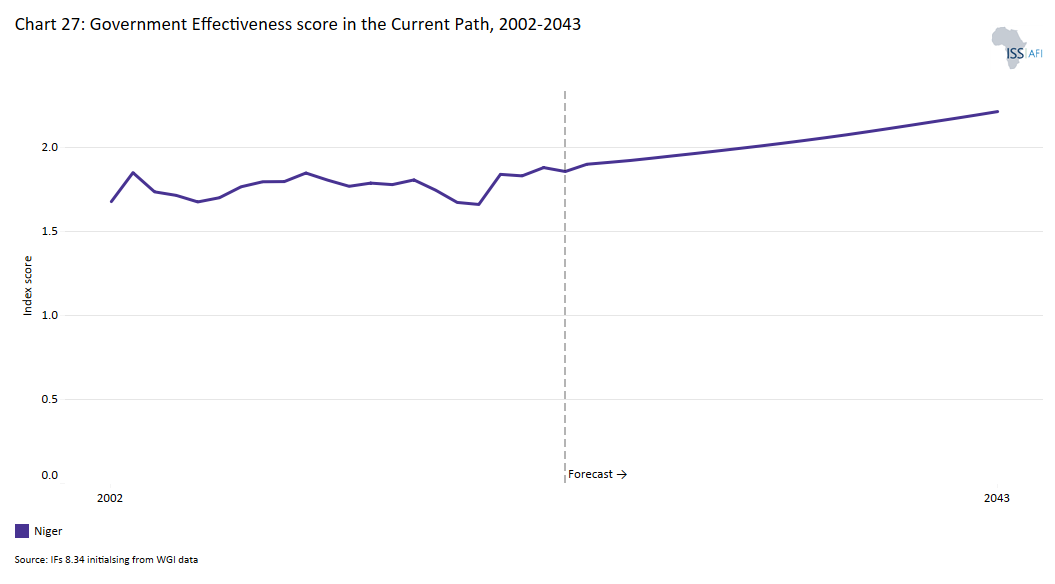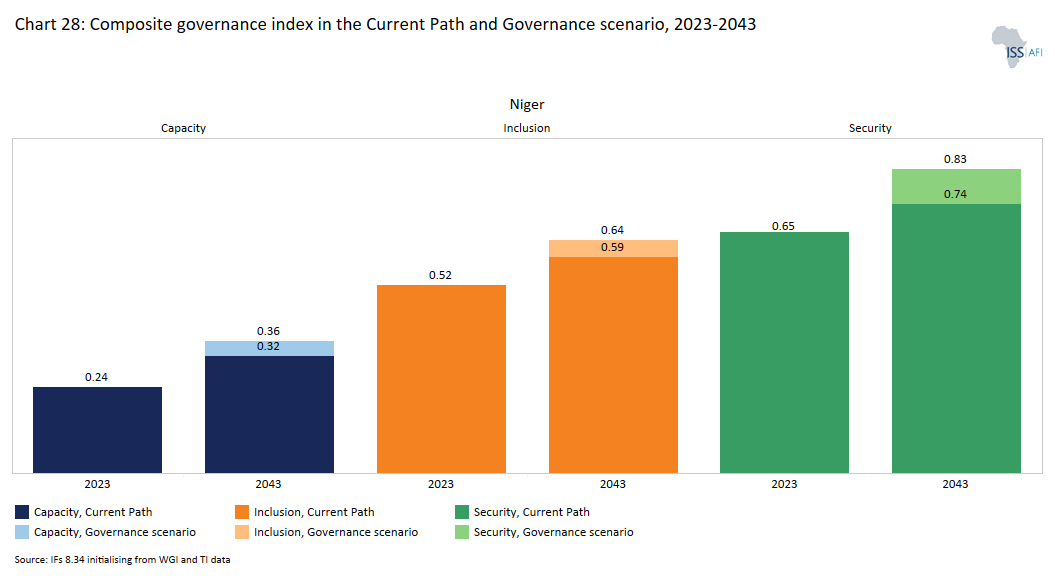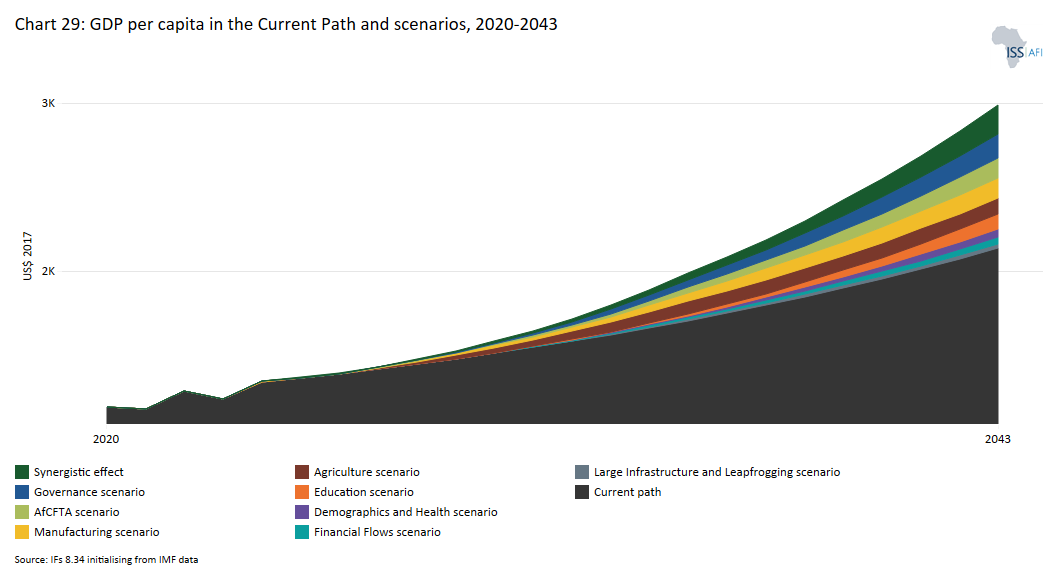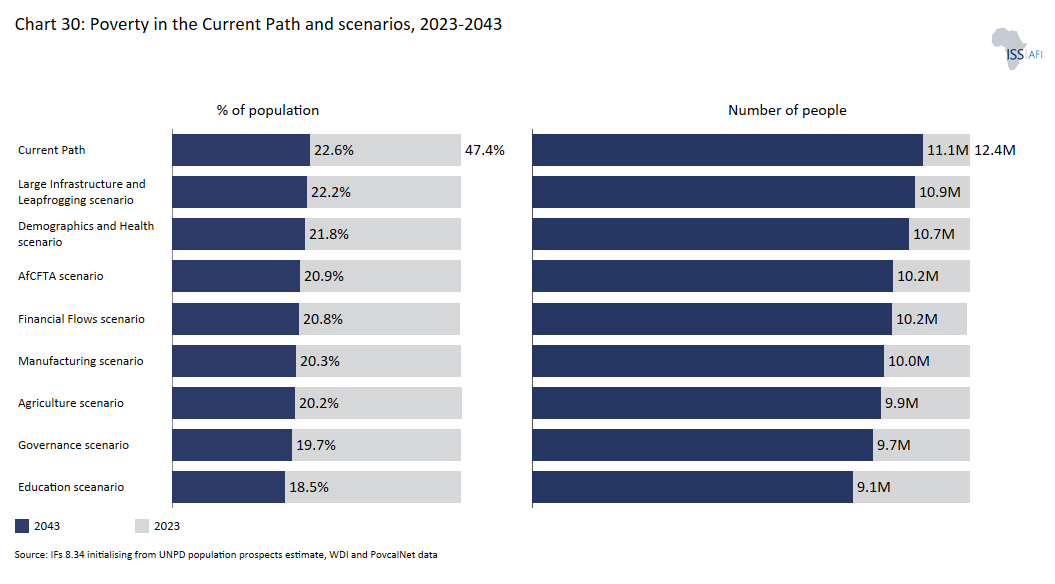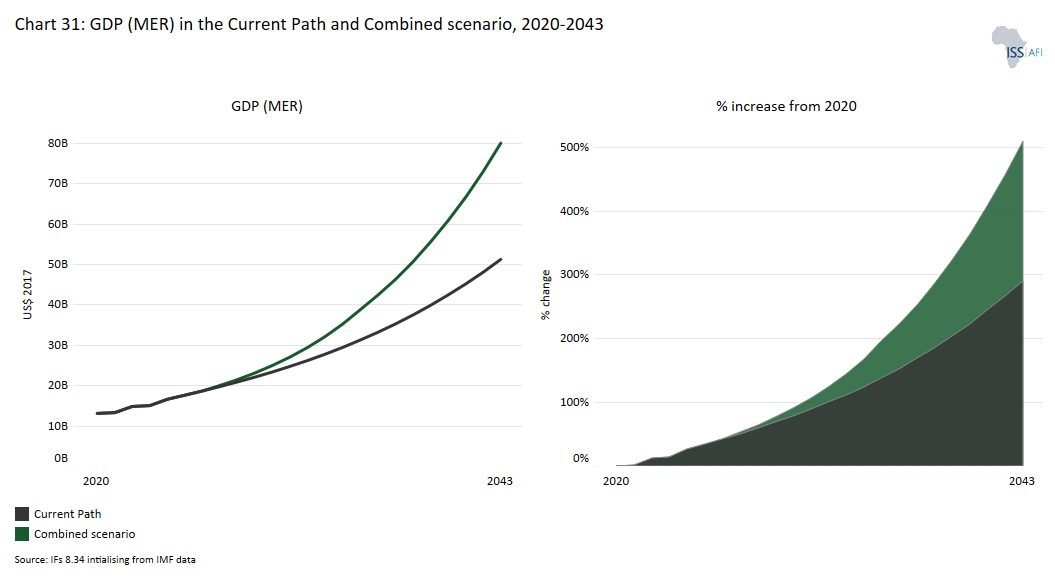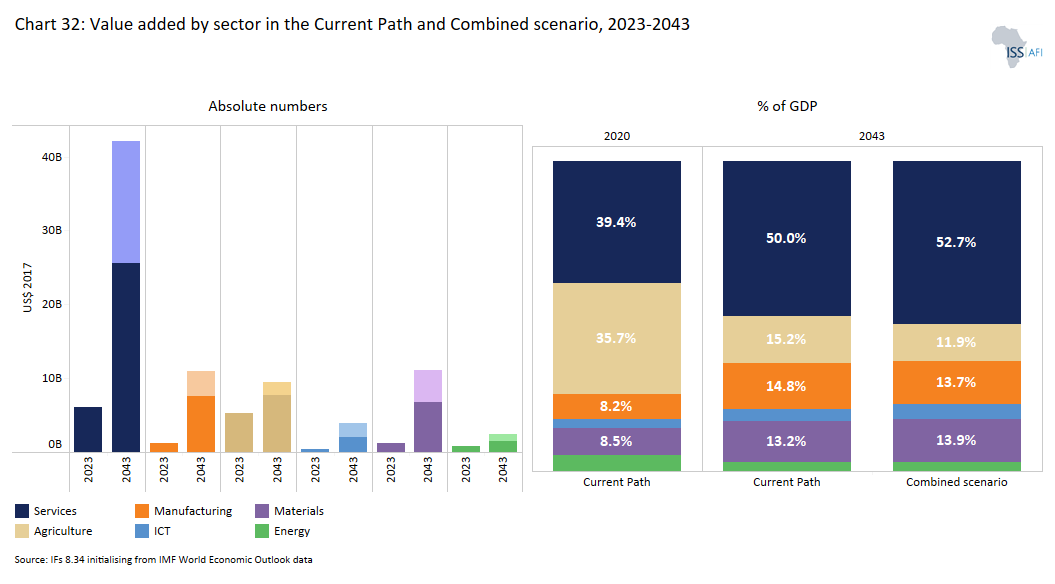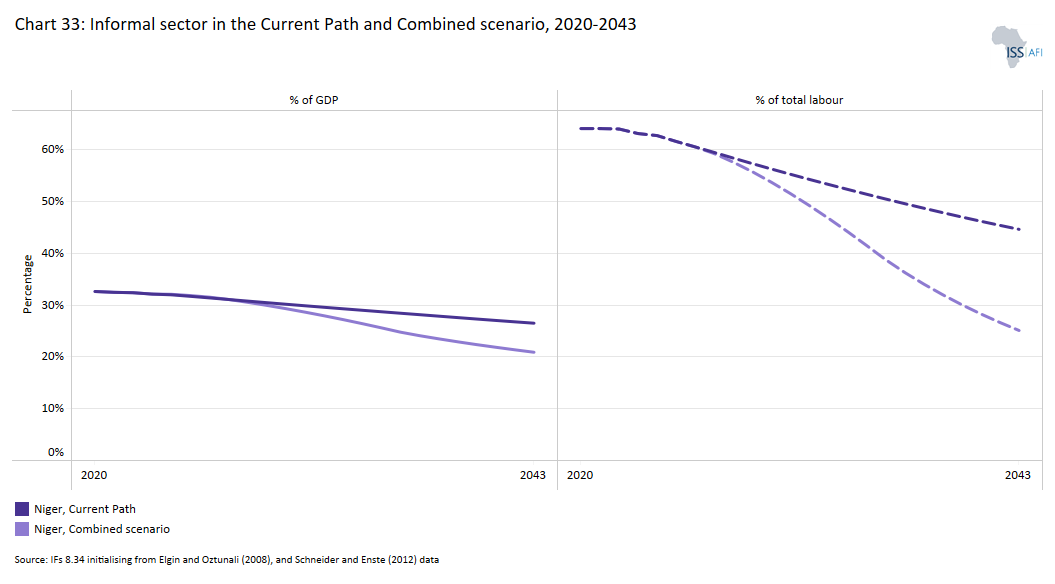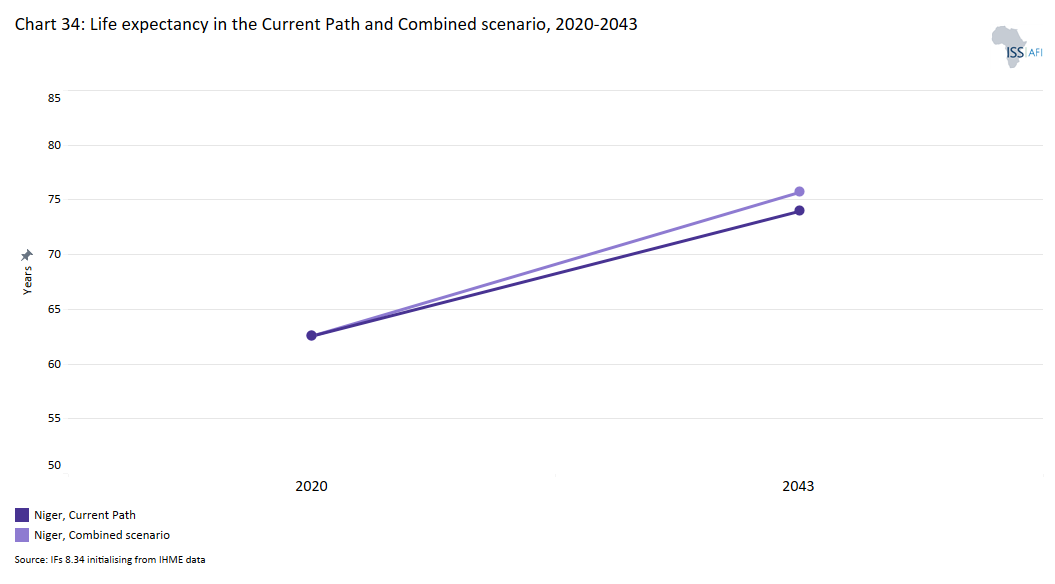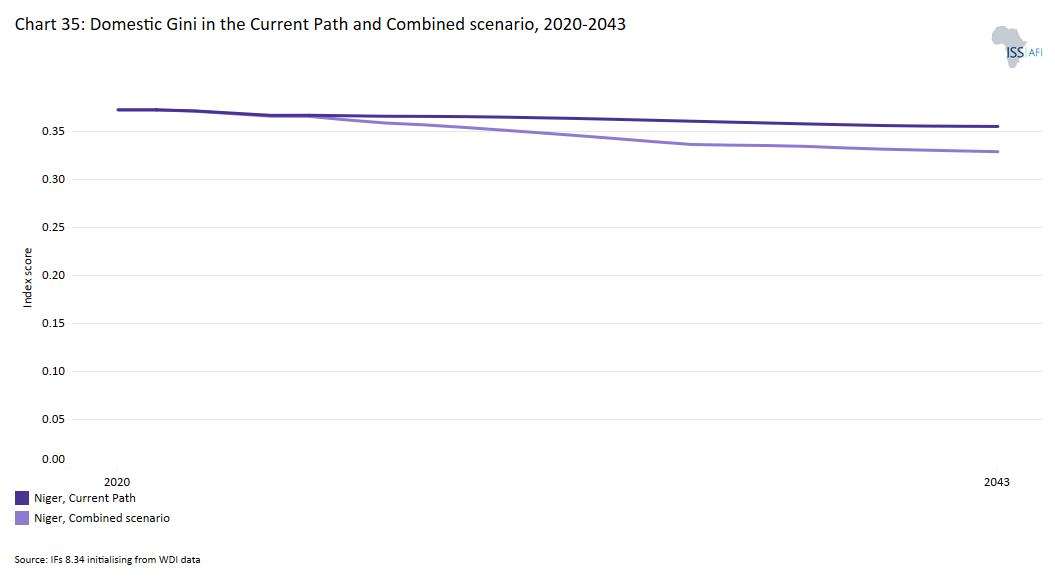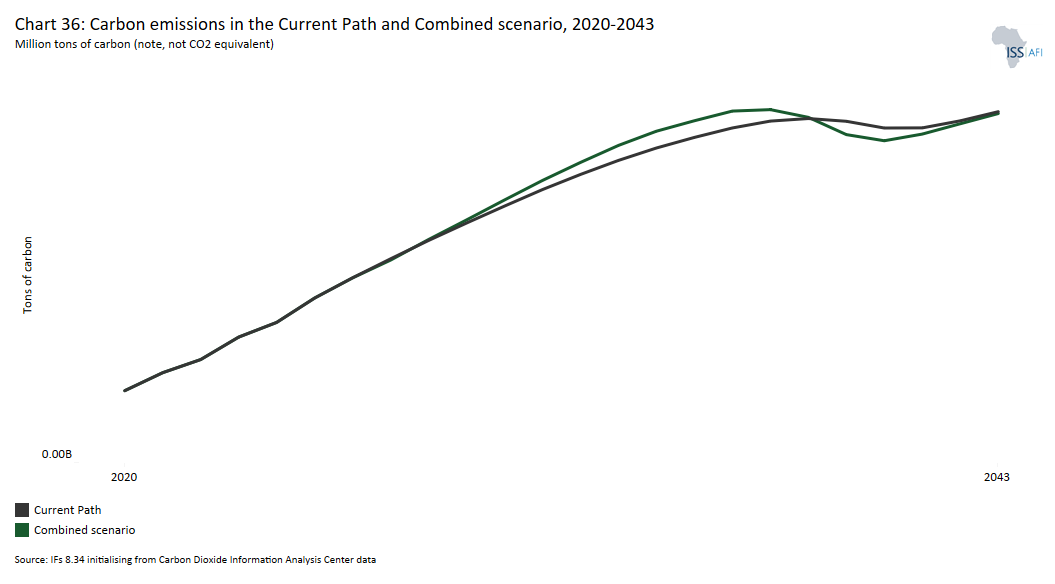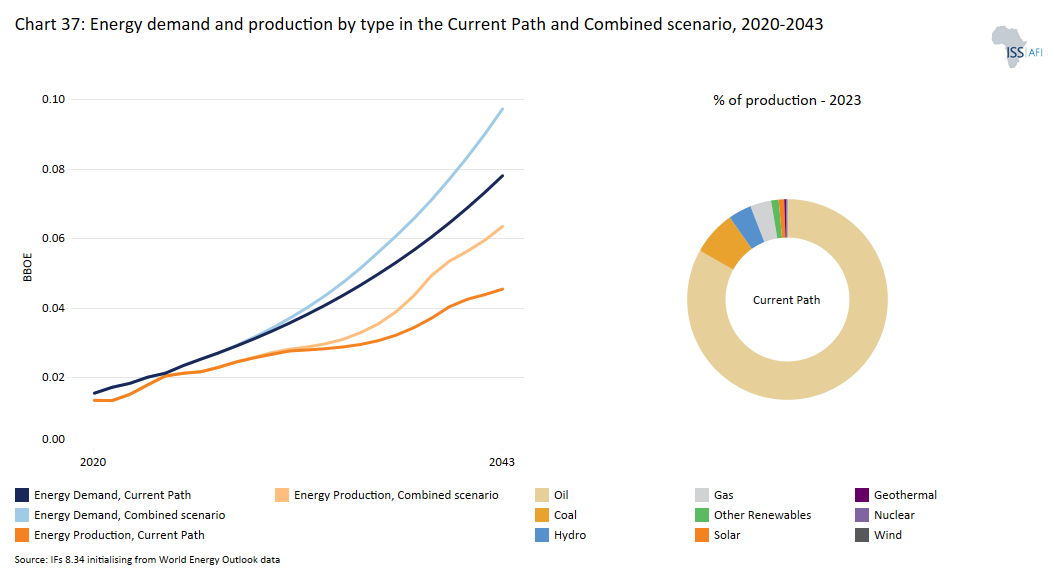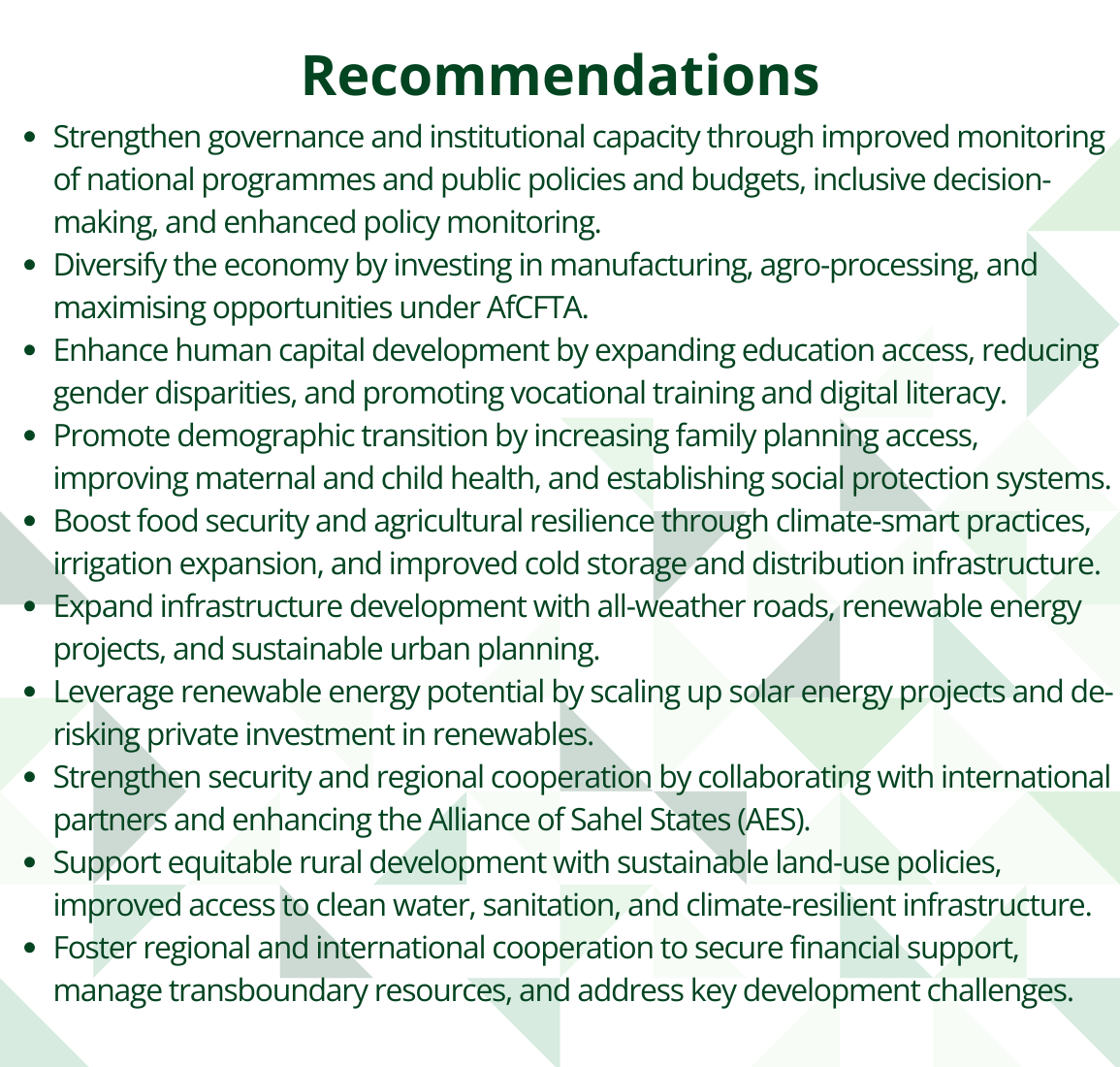 Niger
Niger
Feedback welcome
Our aim is to use the best data to inform our analysis. See our Technical page for information on the IFs forecasting platform. We appreciate your help and references for improvements via our feedback form.
This page presents a comprehensive analysis of Niger. The analysis outlines the nation's extensive socio-economic challenges and opportunities, examining various developmental paths through 2043. It discusses the significant economic growth potential from its rich natural resources while noting the country's persistent issues with poverty, governance and infrastructure. Various scenarios consider the impacts of improvements in sectors like agriculture, education, and manufacturing. The analysis aims to provide policymakers and researchers insights to guide Niger towards a more prosperous future.
For more information about the International Futures modelling platform we use to develop the various scenarios, please see About this Site.
Summary
This page begins with an introductory assessment of the country’s context, looking at current population distribution, social structure, climate and topography.
- Niger, a low-income, landlocked country in Western Africa, covers approximately 1.27 million square kilometres. The population of 26 million in 2023 is heavily concentrated in the southern regions along the border with Nigeria, where the land is more fertile, while the northern and central areas are predominantly arid desert or semi-arid grazing land. Niger’s climate is among the world’s hottest, with minimal rainfall ranging from 100 mm annually in the north to 600 mm in the south, creating vulnerabilities for agricultural and livestock-dependent livelihoods. Despite its significant natural resources, including uranium, coal, gold and oil, socio-economic development is hindered by political instability,
This section is followed by an analysis of the Current Path for Niger which informs the region’s likely current development trajectory to 2043. It is based on current geopolitical trends and assumes that no major shocks would occur in a ‘business-as-usual’ future.
- The population of Niger has one of the highest growth rates globally, at 3.4% annually, driven by a fertility rate of 6.1 births per woman in 2023. The population will grow from 26 million in 2023 to 33.1 million by 2030 and 49 million by 2043, presenting significant challenges for infrastructure, resource management and economic development.
- Niger’s GDP increased from US$3.9 billion in 1990 to US$15.1 billion in 2023. It will reach US$23.4 billion by 2030 and US$51.3 billion by 2043. This represents an average annual growth rate of 6.3% from 2024 to 2043. However, this trajectory depends on effective responses to regional instability, climate shocks and governance challenges.
- The GDP per capita (PPP constant 2017) for Niger was US$1 240 in 2023, placing it among the lowest globally. By 2030, it will rise to US$1 509 and US$2 133 by 2043, though still below the average for low-income Africa.
- The poverty rate, measured at the international poverty line of US$2.15/day, declined from 79.5% in 2007 to 47.4% in 2023. By 2043, the poverty rate will decline to 22.6% in the Current Path. However, rural poverty remains disproportionately high, exacerbated by reliance on climate-sensitive agriculture.
- In recent years, Niger has implemented medium-term plans, including the Niger 2035 Sustainable Development and Inclusive Growth Strategy and its associated PDES plans, aiming to foster security, economic diversification and social resilience. However, the 2023 military takeover and subsequent political instability have disrupted the country's governance and development agenda.
The next section compares progress on the Current Path with eight sectoral scenarios. These are Demographics and Health; Agriculture; Education; Manufacturing; the African Continental Free Trade Area (AfCFTA); Large Infrastructure and Leapfrogging; Financial Flows; and Governance. Each scenario is benchmarked to present an ambitious but reasonable aspiration in that sector.
- The implementation of the Demographics and Health scenario will significantly reduce infant and maternal mortality in Niger. Infant mortality will decline to 11 deaths per 1 000 live births by 2043, reaching the Sustainable Development Goal target of 12 by 2041, compared to 15.7 on the Current Path. Maternal mortality will drop to 157.7 deaths per 100 000 live births by 2043, below the low-income Africa average of 180.8. These improvements, along with enhanced family planning and WaSH infrastructure, will accelerate Niger's demographic transition. However, the demographic dividend will only be achieved by 2058, underscoring the need for sustained efforts to lower fertility rates and improve health outcomes to unlock long-term economic growth opportunities.
- In the Agriculture scenario, Niger’s crop production increases significantly, reducing food import dependence from the Current Path forecast of 24% to 18.8% by 2030 and from 36.6% to 24.9% by 2043. Total agricultural production will rise to 31.4 million metric tons by 2043, 4.3 million tons above the Current Path. This scenario also enhances food security, reduces malnutrition, and supports sustainable agricultural practices, bolstering livelihoods in a sector that employs 71% of the population.
- In the Education scenario, Niger sees significant progress in education outcomes. The mean years of education for adults aged 15 to 24 increases to 6 by 2030 and 8.8 by 2043, compared to 5.7 and 6.9 in the Current Path. Primary school test scores rose from 18.4 in 2023 to 24.2 by 2043, and secondary test scores improved to 33. The scenario also enhances gender parity, vocational training and enrolment across all education levels. These improvements will equip more Nigeriens with the skills needed for a modern workforce and support long-term economic development.
- In the Manufacturing scenario, Niger sees significant growth in its manufacturing sector through increased investments, enhanced R&D and improved business regulations. By 2043, manufacturing’s contribution to GDP rises to 19.2%, compared to 14.8% on the Current Path. The sector's value-add grows to US$9.9 billion by 2043, US$2.3 billion more than in the Current Path.
- The African Continental Free Trade Area (AfCFTA) scenario could significantly boost Niger's trade by increasing exports across various sectors, including manufacturing, agriculture and ICT, while reducing tariffs and improving productivity. Under this scenario, exports will rise to 31.2% of GDP by 2043 compared to 25.4% in the Current Path, while imports will grow more moderately, improving the trade balance. The trade deficit will shrink from 17.9% of GDP in 2023 to 2.4% by 2043 in the AfCFTA scenario, compared to 5.2% in the Current Path. This scenario could also help Niger overcome the limitations of its small domestic market by providing access to larger regional and continental markets.
- The Large Infrastructure and Leapfrogging scenario could significantly enhance Niger's development by improving transport, energy and digital infrastructure. By 2043, this scenario envisions increased electricity access, with modern fuel use reaching 1.5 million households, reducing health risks and environmental degradation caused by traditional cookstoves. It would also boost mobile broadband access to 133 subscriptions per 100 people, compared to 114.7 in the Current Path, while fixed broadband subscriptions could rise to 22.5 per 100 people, fostering digital inclusion and economic growth. Investments in all-season roads, renewable energy and broadband connectivity would improve rural access to markets and services, reduce inequality and enable digital innovation.
- The Financial Flows scenario assumes a return to constitutional governance, restoring donor confidence and attracting external investments. Under this scenario, government revenue will increase to 21.4% of GDP by 2030 and 24.8% by 2043, compared to 20.6% and 23.2% in the Current Path. The rise in external capital inflows, combined with improved tax collection and targeted tax incentives, would strengthen Niger's fiscal capacity, enabling greater investment in public services and infrastructure. However, the success of this scenario hinges on Niger’s ability to rebuild investor confidence and maintain transparent and efficient tax collection systems.
- The Governance scenario will improve Niger’s governance effectiveness to 2.2 out of 5 by 2043, compared to 2.0 in the Current Path, positioning the country above the low-income Africa average, but below the global benchmark of 3.1. The inclusion index, reflecting democratic participation and gender equity, will rise to 0.62 by 2043, compared to 0.57 in the Current Path, while the capacity index, measuring institutional effectiveness, will increase to 0.35, up from 0.24 in 2023. The security index will also see a modest rise to 0.68 by 2043, compared to 0.65 in the Current Path. Government revenue will grow to 24.8% of GDP, enabling increased spending on social protection and public services. These improvements reflect stronger institutions, monitoring and policies as well as enhanced inclusivity, supporting sustainable development and greater stability.
In the third section, we compare the impact of each of these eight sectoral scenarios with one another and subsequently with a Combined scenario (the integrated effect of all eight scenarios). In our forecasts, we measure progress on various dimensions such as economic size (in market exchange rates), gross domestic product per capita (in purchasing power parity), extreme poverty, carbon emissions, the changes in the structure of the economy, and selected sectoral dimensions such as progress with mean years of education, life expectancy, the Gini coefficient or reductions in mortality rates.
- The Combined scenario delivers significant improvements across various dimensions of development, underscoring the transformative potential of integrated interventions. GDP per capita increases by 25% in the Combined scenario by 2043 compared to the Current Path. Extreme poverty declines substantially, dropping from 28% in the Current Path to 22%, with the Agriculture and Governance scenarios making the largest contributions to this reduction. Mean years of education for adults aged 15 to 24 improve from 6.9 years in the Current Path to 8.5 years in the Combined scenario by 2043, while life expectancy rises from 72.8 years to 74.5 years over the same period. Although carbon emissions are expected to increase, this small increase reflects sustainable growth in industrial and agricultural sectors. Income inequality, measured by the Gini coefficient, also sees notable improvement, with the Governance scenario achieving the most significant reduction, highlighting the importance of inclusive and equitable development.
We end this page with a summarising conclusion offering key recommendations for Niger's inclusive and sustainable development. Addressing governance challenges is critical, with a focus on inclusive decision-making and institutional strengthening to restore public trust and ensure effective policy implementation. Economic diversification, particularly through investments in manufacturing, agro-processing and renewable energy, alongside leveraging AfCFTA opportunities, can reduce dependence on resource exports and drive growth. Human capital development must prioritise education access, gender equality and vocational training to harness Niger's demographic potential, while efforts to promote a demographic transition through improved healthcare and family planning will alleviate strain on resources. Expanding climate-smart agriculture, irrigation and food storage infrastructure can enhance food security and resilience. Finally, investments in all-weather roads, renewable energy and urban planning are essential to improve connectivity, energy access and manage urbanisation, while strengthening regional cooperation and security frameworks remains pivotal for stability and sustained progress.
All charts for Niger
- Chart 1: Political map of Niger
- Chart 2: Population structure in the Current Path, 2020–2043
- Chart 3: Population distribution map, 2023
- Chart 4: Urban and rural population in the Current Path, 1990-2043
- Chart 5: GDP (MER) and growth rate in the Current Path, 1990–2043
- Chart 6: Size of the informal economy in the Current Path, 2020-2043
- Chart 7: GDP per capita in Current Path, 1990–2043
- Chart 8: Extreme poverty in the Current Path, 2020–2043
- Chart 9: National Development Plan of Niger
- Chart 10: Relationship between Current Path and scenarios
- Chart 11: Mortality distribution in the Current Path, 2023 and 2043
- Chart 12: Infant mortality rate in Current Path and Demographics and Health scenario, 2020–2043
- Chart 13: Demographic dividend in the Current Path and the Demographics and Health scenario, 2020–2043
- Chart 14: Total agricultural production and demand in the Current Path, 1990-2043
- Chart 15: Import dependence in the Current Path and Agriculture scenario, 2020–2043
- Chart 16: Progress through the education funnel in the Current Path, 2023 and 2043
- Chart 17: Mean years of education in the Current Path and Education scenario, 2020–2043
- Chart 18: Value-add by sector as % of GDP in the Current Path, 2023 and 2043
- Chart 19: Value-add by the manufacturing sector in the Current Path and Manufacturing scenario, 2020–2043
- Chart 20: Exports and imports as % of GDP in the Current Path, 2000-2043
- Chart 21: Trade balance in the Current Path and AfCFTA scenario, 2020–2043
- Chart 22: Electricity access: urban, rural and total in the Current Path, 2000-2043
- Chart 23: Cookstove usage in the Current Path and Large Infra/Leapfrogging scenario, 2020–2043
- Chart 24: Access to mobile and fixed broadband in the Current Path and the Large Infra/Leapfrogging scenario, 2020–2043
- Chart 25: FDI, foreign aid and remittances as % of GDP in the Current Path and in the Financial Flows scenario, 1990-2043
- Chart 26: Government revenue in the Current Path and Financial Flows scenario, 2020–2043
- Chart 27: Government effectiveness score in the Current Path, 2002-2043
- Chart 28: Composite governance index in the Current Path and Governance scenario, 2023 and 2043
- Chart 29: GDP per capita in the Current Path and scenarios, 2020–2043
- Chart 30: Poverty in the Current Path and scenarios, 2023–2043
- Chart 31: GDP (MER) in the Current Path and Combined scenario, 2020–2043
- Chart 32: Value added by sector in the Current Path and Combined scenario, 2023 and 2043
- Chart 33: Informal sector in the Current Path and Combined scenario, 2020–2043
- Chart 34: Life expectancy in the Current Path and Combined scenario, 2020–2043
- Chart 35: Domestic Gini in the Current Path and Combined scenario, 2023 and 2043
- Chart 36: Carbon emissions in the Current Path and Combined scenario, 2020–2043
- Chart 37: Energy demand and production by type in the Current Path and Combined scenario, 2020-2043
- Chart 38: Policy recommendations
Chart 1 is a political map of Niger.
Niger, a landlocked country in Western Africa, is classified as low-income and shares borders with Algeria, Libya, Chad, Nigeria, Benin, Burkina Faso and Mali. Spanning approximately 1.27 million square kilometres, Niger is rich in natural resources, including uranium, coal, iron ore, tin and petroleum. These resources have historically contributed to government revenues, attracted foreign investment and supported infrastructure projects. However, the equitable distribution of these benefits has been hindered by challenges in resource management and periods of political instability.
The capital city, Niamey, is situated in the southwestern region, which hosts the highest population density and serves as a hub for the majority of agricultural activities. In contrast, the northern regions are predominantly desert, while central areas provide grazing lands for the livestock of nomadic pastoralist communities.
The country is located in one of the world's hottest zones, with minimal annual rainfall, ranging from 100 mm in the northern Saharan region to 600 mm in the southern Sahelian zone. The rainy season, lasting one to four months, heavily influences agriculture and water availability throughout these zones. Ecologically, the country spans arid deserts, transitional savannas and a small fertile southern zone, home to diverse but threatened wildlife. Challenges like desertification (spanning southwards) and climate change (specifically affecting rainfall variability) exacerbate vulnerabilities, adding pressure to an already fragile socio-economic and political landscape.
Since gaining independence from French colonial rule in 1960, Niger has navigated periods of political instability interspersed with relative calm. The initial phase of one-party civilian governance lasted until a military coup in 1974, ushering in military rule that persisted until 1991. Niger became a democratic state following the Sovereign National Conference in 1992, which led to the adoption of a new constitution authorising a multi-party system. The first president was democratically elected in 1993. Subsequent years saw coups occuring in 1996 and 1999, followed by the election of former president Mamadou Tandja, who served two terms until 2009. An attempt to amend the constitution for a third term led to another military intervention in 2010. Elections in 2011 brought Mahamadou Issoufou to power, who completed two terms before peacefully transferring authority to Mohamed Bazoum in 2021, marking Niger's first peaceful transition between democratically elected leaders, despite the opposition contesting the election.
However, this period of democratic rule was short-lived. On 26 July 2023, President Bazoum was deposed in a military coup led by General Abdourahamane Tchiani, who assumed leadership of the National Council for the Safeguard of the Homeland (Conseil National pour la Sauvegarde de la Patrie, or CNSP). The military-led government cited deteriorating security conditions and economic mismanagement as justifications for the takeover.
In the aftermath of the July 2023 coup, Niger's political landscape underwent significant shifts. The military-led government severed longstanding security agreements with France, leading to the withdrawal of French troops by December 2023. The US also evacuated and closed its drone base in Agadez in August 2024 at the request of the military-led government. Following its strained relations with ECOWAS and regional tensions, Niger, alongside Burkina Faso and Mali, announced its withdrawal from the Economic Community of West African States (ECOWAS) and the G5 Sahel. The three nations formally exited the Community on 29 January 2025 after forming the Alliance of Sahel States (ASS) in September 2023 to jointly address security challenges and strengthen regional defense cooperation. This military alliance later evolved into the broader Confederation of Sahel States (CSS) in August 2024, formalising their collaboration on political, economic and diplomatic efforts to assert sovereignty and foster independence in the Sahel region. Niger currently uses the West African Franc (CFA) and is part of the West Africa Economic and Monetary Union, but the country has stated its intent to stop using the CFA in favour of creating a common currency with the CSS.
Niger is also a member of the Niger Basin Authority, which enables member states to jointly manage the water resources of the Niger Basin in a sustainable manner, the Lake Chad Basin Commission, which has the same aims for the Lake Chad Basin region and the Liptako–Gourma Authority, which aims to develop and secure the border regions between Mali, Burkina Faso and Niger.
Despite these realignments, the security situation remains precarious. The drawdown of Western military support has created security gaps that have been exploited by Islamist insurgent groups, contributing to a rise in attacks. The military-led government has sought support from alternative partners, including China, Russia and Türkiye. However, tangible improvements in the security situation remain limited. Furthermore, internal dissent has emerged, with new non-state armed groups expressing support for the deposed President Bazoum. The most active are the Patriotic Liberation Front and the Patriotic Front for Justice, which carried out several attacks in 2024 against Niger's military and infrastructure.
While the military-led government implemented measures to address internal challenges, such as establishing a new anti-corruption commission aimed at recovering misappropriated public assets and improving the monitoring of national programs and public policies and budgets, concerns have been raised regarding the transparency and effectiveness of these initiatives. Overall, Niger’s political landscape remains fraught with challenges, and the path to stability and democratic governance is uncertain.
Niger’s social indicators also reflect persistent developmental challenges. The United Nations Human Development Index (HDI) for 2024 places Niger at 189th out of 191 countries, with a score of 0.394, significantly below the sub-Saharan Africa average of 0.549. Similarly, the Sustainable Development Report 2024 SDG index ranks Niger 160th out of 167 countries, highlighting substantial gaps in achieving the Sustainable Development Goals (SDGs).
Niger is at a critical juncture, confronted by political upheaval, security threats, economic disruptions and enduring developmental challenges. The recent coup and subsequent policy shifts have introduced new dynamics that will significantly influence the country's trajectory in the coming years, as explored in the sections below.
Chart 2 presents the Current Path of the population structure, from 2020 to 2043.
Niger has one of the highest annual population growth rates globally, measured at 3.4% in 2023. Its exceptionally high fertility rate of 6.1 births per woman has driven rapid population growth, from 8.3 million in 1990 to 26.2 million in 2023, with our modelling forecasting 33.1 million by 2030 and 49 million by 2043. This growth poses significant challenges to sustainable development, placing pressure on resources, infrastructure and social systems.
Adding to the complexity are strained social budgets, with competing demands arising from increased security spending linked to high regional instability. These budgetary pressures inevitably reduce allocations for long-term development sectors like health, education and social protection, further exacerbating the challenges of rapid population growth.
The high fertility rate, historically above 7 until 2017, is accounted for by limited family planning and cultural norms favouring large families. In 2023, contraceptive use was just 12.7%, the 8th lowest globally. By 2030, this will rise to 18.9%, and by 2043, it will reach 29.9%, still one of the lowest rates worldwide. This low uptake will contribute to higher than global average fertility rates, which will stand at 5.4 births per woman by 2030 and 4.1 births by 2043.
A high fertility rate coupled with low levels of life expectancy meant Niger had the world’s youngest population in 2023. Niger's median age was 16 years in 2023, with half of the population expected to be under 17 years by 2030. This youthful population, while contributing to a growing future labour force, also increases the dependency ratio, potentially limiting economic development. The median age of the population will reach 19.4 years by 2043.
Life expectancy in Niger will improve, from 64.8 years in 2023 to 69.2 years in 2030 and by 2043 would likely be 74 years, reflecting a strong positive trend. The elderly, those aged above 64 years, will remain a small part of the population, rising from 2.6% in 2023 to 3.4% by 2043. However, a potential demographic dividend will materialise only around 2060 when the ratio of the working-age population (15 to 64 years of age) to dependants (elderly and children) will reach 1.7 to 1. Until then, high dependency ratios will limit the contribution that labour can make to economic growth as well as to savings and investment.
Niger has a significant youth bulge, with 51.5% of the adult population aged between 15-29 years in 2023, the fourth largest globally. Despite a low youth unemployment rate of 0.4% in 2022, economic opportunities and political stability will be key to avoiding instability. The youth bulge will remain high throughout the forecast horizon, amounting to 51.7% in 2030 and only dropping slightly to 47.9% by 2043. In the context of Niger, its large youth bulge, the limited economic opportunities afforded to young adults entering the job market, and the perceptions of the limited degree of political agency by young people contribute to instability.
The government should prioritise addressing these issues. To harness the potential of its youthful population and minimise the risks of social and economic instability, it is essential to expand access to education, create employment opportunities, strengthen social protection, and improve governance — underpinned by ongoing dialogue and engagement.
Chart 3 presents a population distribution map of Niger for 2023.
Niger’s population of approximately 26 million is unevenly distributed, with most people living in clusters concentrated in the far south and west of the country. Due to its vast arid landscape—covering about 80% of the total land area—Niger has a low overall population density. An estimated 94% of the population resides on just 35% of the land, primarily in the more fertile southern regions along the border with Nigeria and around major river systems. The national average population density was 0.21 people per square kilometre in 2023 and will rise gradually to 0.26 by 2030 and 0.39 by 2043, reflecting slow urbanisation and the dominance of rural living.
Niamey, the capital and largest city, is situated in the southwest along the River Niger. It serves as the political, economic and cultural hub of the country, with an expanding urban footprint driven by population growth. Maradi, the second-largest city, and Zinder, the third-largest, are both located in the southern region near the Nigerian border, serving as important trade and agricultural centres.
Despite its geographical isolation and limited connectivity, the city of Agadez in the north plays a critical role in linking Niger to Algeria via the Trans-Saharan Road (TSR) corridor and between Niger and Libya via the Salvador pass, which are key corridors for regional trade and migration.
The southern regions of Niger benefit from relatively better connectivity through major roadways, such as the Niamey-Cotonou Corridor and the Zinder-Kano Road. The Niamey-Cotonou Corridor, once a vital trade route linking the capital to Benin's port city of Cotonou, has been disrupted due to border closures following diplomatic tensions after Niger's 2023 coup and ECOWAS sanctions. Meanwhile, the Zinder-Kano Road continues to play a critical role in fostering economic ties with Nigeria, Niger’s largest trading partner. Despite these important routes, the country’s overall road infrastructure remains underdeveloped, with limited paved roads and poor maintenance, creating significant challenges for national connectivity and economic integration.
Niger’s land use management is heavily influenced by its arid environment, with significant variations across regions. The country is divided into eight administrative regions—Agadez, Diffa, Dosso, Maradi, Tahoua, Tillabéri and Zinder—and the capital district, Niamey. These regions are further subdivided into 63 departments, a substantial increase from the 36 departments that existed prior to the administrative reorganisation implemented in 2011. Enhancing transport networks and upgrading key trade corridors are essential for improving connectivity between population clusters, unlocking economic opportunities, and supporting equitable development across the diverse landscapes of Niger.
Effective land use management in the southern areas would also be vital to ensuring sustainable agricultural practices, protecting fertile lands, and accommodating population growth in a way that balances development needs with environmental preservation.
Chart 4 presents the urban and rural population in the Current Path, from 1990 to 2043.
Niger has been slower to urbanise compared to global trends, with the majority of its population still living in rural areas. In 2023, 82.4% of the population lived in rural areas, the third-highest rate globally, behind Papua New Guinea and Burundi. By 2030, the rural population proportion will drop marginally to 81.2%, and by 2043, it will reach 78.5%, still ranking 6th globally. This slow transition signals a prolonged reliance on agriculture and rural livelihoods, which may hinder the country’s overall development if not accompanied by appropriate policy adjustments and infrastructure investments.
Urbanisation, when it occurs, can be a key driver of economic growth, as higher population densities in cities and towns foster entrepreneurship, increase productivity, and lead to higher rates of educational attainment and healthcare access. However, rural populations in Niger face persistent challenges due to limited access to critical services and infrastructure, including healthcare, education and reliable internet access, further deepening disparities.
More rapid rates of urbanisation could help address some of these disparities by offering better access to essential services and creating new economic opportunities - but only with prior planning and the pre-placement of infrastructure. It could present an opportunity for comprehensive urban planning reforms and climate adaptation strategies, particularly in the housing sector, which currently struggles with affordability and resilience to climate shocks. Nevertheless, this urban transition carries risks, such as the rapid and often uncontrolled expansion of informal settlements. These settlements frequently lack basic infrastructure, sanitation and essential services, posing challenges to public health and social stability. Moreover, while urbanisation can drive development within cities, it could exacerbate the rural-urban divide if not paired with strategic policies aimed at improving rural infrastructure, agricultural productivity and access to services.
Balancing rural development, especially addressing challenges like frequent droughts and erratic rainfall patterns within Niger’s agricultural sector, with urban growth priorities will be crucial to ensuring inclusive, sustainable progress across all regions of Niger. A comprehensive approach that fosters both urban and rural development is necessary to reduce inequalities and ensure long-term prosperity.
Chart 5 presents GDP in market exchange rates (MER) and growth rate in the Current Path, from 1990 to 2043.
The country is heavily dependent on the agriculture sector which is vulnerable to climate-related shocks, such as erratic rainfall patterns and droughts, due to a lack of irrigated agricultural land. Irrigation is however on the rise, and in 2023 production from irrigated land compensated for decreased rain-fed production of key cereals, highlighting the benefits of increased irrigation.
Economic output is hampered by ongoing domestic and regional insecurity, which affects regional integration, access to markets and strains public finances. The level of human capital development is also an obstacle to economic growth, while limited infrastructure and growing insecurity constrain educational access. Political upheaval in 2023 also disrupted the country’s economic productivity, when the Economic Community of West African States (ECOWAS) and the West African Economic and Monetary Union (WAEMU) imposed far-reaching sanctions on various sectors of the economy, which contributed to lower-than-projected growth in 2023. The lifting of key sanctions, for humanitarian reasons, in February 2024 — such as border closures, trade restrictions, and the suspension of financial transactions — combined with the partial restoration of financing, contributed to stronger-than-expected economic growth that year.
Niger relies primarily on gold production, which constituted 72.7% of total exports in 2022, while other mineral products contributed an additional 8.6%. The export of oil was expected to increase significantly by the end of 2023, but sanctions imposed by neighbouring states (subsequently lifted) delayed the process, leading to a delay in oil exports through a newly built pipeline running through Benin. The pipeline finally opened in April 2024, and again in August, after a dispute with Benin was settled. The pipeline has a 110 000 barrel per day capacity, which is a fivefold increase on the country’s current production capabilities, with production expected to initially start at 90 000 barrels per day. The expected increase in oil revenue has boosted the projected average growth of the economy in 2025 and 2026 above 6%. Non-oil industries and the services sectors will however take longer to recover from the economic shock caused by the 2023 political upheaval.
Uranium, once a cornerstone of Niger's exports, has experienced a significant decline in production and export value over the past decade. In 2022, Niger produced approximately 2 020 tonnes of uranium, accounting for around 5% of global uranium production. Recent political tensions between Niger and France have further impacted the sector. In June 2024, Niger's military government revoked the operating license of French nuclear company Orano for the Imouraren mine, one of the world's largest uranium deposits. Orano, which has been active in Niger since 1971, has faced operational challenges, including the suspension of production at its Somaïr mine due to financial difficulties and export restrictions.
The size of Niger’s economy stood at US$15.1 billion in 2023 and will grow by 55% to reach US$23.4 billion in 2030. Growth in the short to medium term will be influenced by various factors, such as the decision to withdraw from ECOWAS and the subsequent rise in tariffs and lower trade volumes, continuing vulnerability to extreme climate patterns which will affect agriculture output, and the persistent threat of national and regional insecurity. Furthermore, borrowing costs will likely be higher and domestic resource mobilisation is forecast to remain low. Nevertheless, Niger’s GDP will increase to US$51.3 billion by 2043, a robust improvement of 120% over its 2030 level. An average growth rate from 2024 to 2043 is expected at 6.3%, which is above the average for low-income African countries, but insufficient to rapidly reduce poverty or grow incomes.
As oil exports start to flow, assuming relations with Benin are strengthened and maintained, care will have to be taken to reinvest the economic gains in the country’s human, social and knowledge capital, to diversify the economy, and to insulate Niger against the price volatility of international oil and commodity markets. Following the start of large-scale oil production and exports, the World Bank estimates that government oil revenues are expected to rise to 5% of GDP by 2030, from less than 1% of GDP in 2024. Part of this windfall can then be used to invest in social sectors in general and education in particular.
Chart 6 presents the size of the informal economy as per cent of GDP and per cent of total labour (non-agriculture), from 2020 to 2043. The data in our modelling are largely estimates and therefore may differ from other sources.
The informal economy comprises the part of any economy that is neither officially taxed nor monitored. Countries with high informality typically face numerous development challenges, such as low revenue mobilisation, and economic growth tends to be below potential. Informal economic activities are also less productive than those in the formal sector, providing workers with little to no social protection and formal contracts. The informal sector is typically also characterised by high levels of gender and income inequality.
Until ECOWAS lifted its sanctions at the start of 2024, the informal economy mitigated some of the negative side effects of trade restrictions on the food security situation in Niger. Informal traders were still able to access the markets of states imposing ECOWAS sanctions, which kept food available, albeit at higher prices. Whilst formalisation of the informal sector remains a priority, the sector provides a crucial lifeline for many people unable to enter the formal sector, a situation that will continue for many years in the future.
Efforts to formalise the sector must therefore be taken with care to protect informal food supply lines and ease the transition from informal to formal. In fact, Niger would be well advised to grow the informal sector in the absence of low formal sector growth since the majority of Niger’s workforce is employed in the informal sector, equating to 63.2% in 2023. The economic size of the sector reached 32.1% of GDP in the same year.
In absolute terms, the sector will continue to grow over the forecast horizon, but as a share of total GDP its contribution will fall to 30.2% by 2030 and 26.5% by 2043. Similarly, informal labour force employment will reduce to 56.3% by 2030 and 44.7% by 2043 on the Current Path.
Chart 7 presents GDP per capita in the Current Path, from 1990 to 2043, compared with the average for the Africa income group.
Modest economic growth coupled with high fertility rates have led to Niger’s GDP per capita being the fifth lowest globally at US$1 240 in 2023. At independence in 1960, the average income per person equated to US$1 740, but years of rapid population growth and slow economic growth meant GDP per capita fell to US$1 080 by 1990. Decades of political instability and multiple coups resulted in economic stagnation, with GDP per capita reaching a low point of US$910 in 2004, before slowly rising to its current level. Compared to the average of its low-income group peers in Africa, Niger fell below the group’s average in 1984, with the gap growing from US$190 in 1990 to US$570 by 2023.
In the Current Path, Niger’s GDP per capita will increase to US$1 509 by 2030 and US$2 133 by 2043, therefore only surpassing its 1960 level of US$1 740 in 2036. The country will continue to fall behind the average for its income group, with the gap remaining at US$570 by 2030 before growing to US$852 by 2043.
Chart 8 presents the rate and numbers of extremely poor people in the Current Path from 2020 to 2043.
In 2022, the World Bank updated the poverty lines to 2017 constant dollar values as follows:
- The previous US$1.90 extreme poverty line is now set at US$2.15, also for use with low-income countries.
- US$3.20 for lower-middle-income countries, now US$3.65 in 2017 values.
- US$5.50 for upper-middle-income countries, now US$6.85 in 2017 values.
- US$22.70 for high-income countries. The Bank has not yet announced the new poverty line in 2017 US$ prices for high-income countries.
Monetary poverty only tells part of the story, however. In addition, the global Multidimensional Poverty Index (MPI) measures acute multidimensional poverty by measuring each person’s overlapping deprivations across 10 indicators in three equally weighted dimensions: health, education and standard of living. The MPI complements the international US$2.15 a day poverty rate by identifying who is multidimensionally poor and also shows the composition of multidimensional poverty. The headcount or incidence of multidimensional poverty is often several percentage points higher than that of monetary poverty. This implies that individuals living above the monetary poverty line may still suffer deprivations in health, education and/or standard of living.
Government efforts to actively combat poverty in Niger started in earnest in 1997 when the Framework Program to Combat Poverty (PCLCP) was adopted. This framework was followed by the Poverty Reduction Strategy (PRS) in 2002, which served as the principal set of guidelines for all economic and social policies. The Strategy focussed on increasing access to basic social services, developing rural areas, fighting food insecurity and desertification and increasing incomes.
The PRS was followed by the Accelerated Development and Poverty Reduction Strategy (ADPRS), which set out the country's poverty alleviation objectives from 2008 to 2012. The ADPRS rested on seven pillars, with the three most pertinent to poverty reduction being equitable access to quality social services, control of population growth, reduction of inequalities, and strengthening of social security.
The next development plan, titled the ‘Economic and Social Development Plan’ (PDES) for the period 2012-2015 focused on sustainable development, inclusive growth and good governance. Building on the foundation of the previous strategies, the PDES focused on greater sustainability, especially in agricultural development and diversifying the economy.
A subsequent PDES was adopted in 2017 and served as the first implementation plan for a newly developed National Growth strategy, termed the Niger 2035 Sustainable Development and Inclusive Growth Strategy (SDIGS). The 2017-2021 PDES focussed on five axes, namely, cultural renaissance, improved governance, social development and a demographic transition, greater economic growth and sustainable management of the environment. A new PDES was adopted in 2022 and runs until 2026, building on the priorities set out for the 2017-2021 period.
These efforts have resulted in steadily decreasing poverty rates since the mid-2000s. In 1981, 66.3% of the population lived below the US$2.15 poverty line, a rate which rose to 79.5% by 2007, due in large part to the political turbulence in the 1990s and early 2000s. However, poverty levels have steadily declined since, dropping to 47.4% by 2023. The vast majority of the extremely poor live in rural areas, while urban areas have relatively low levels, especially in the capital city of Niamey. Covid-19 reversed some of the gains made in reducing poverty, particularly in rural areas, and constrained access to health and education, which was already low.
The natural hazards facing the agriculture sector will continue to be a large risk factor for poverty reduction efforts in Niger, as the sector employs most of the country’s poor population. The poverty rate will however continue to steadily decline over the forecast horizon, reaching 38.5% in 2030 and 22.6% by 2043.
Chart 9 depicts the National Development Plan.
The overarching development strategy was adopted in 2017 and is titled the Niger 2035 Sustainable Development and Inclusive Growth Strategy (SDIGS). Two medium-term development plans have been formulated to implement the strategy, titled PDES 2017-2021 and PDES 2022-2026. The SDIGS rests on six strategic axes:
- Security of the territory
- Development of a dynamic private sector
- Demographic transition
- Revitalisation and Modernisation of Rural Areas
- Human capital development
- Modernisation of government institutions
To achieve these goals, the PDES 2022-2026 stipulates three axes of its own:
- Human capital development, inclusion and solidarity
- Strengthening Governance, Peace and Security
- Transforming the structure of the economy
The PDES 2022-2026 aims to boost progress towards these three priorities by ensuring its population enjoys food security, has access to clean water and sanitation services, and does not experience gender-based discrimination. The plan also focuses on greater internal security, better border management and better local governance. Lastly, to promote the structural transformation of the economy, the Plan commits to revitalising the private sector, the sustainable management of the environment and productive use of oil and mineral resources.
The PDES 2022-2026 plan importantly identifies a series of factors that will ensure it is implemented successfully:
- Establishing and operationalising the needed institutional bodies
- Allocating sufficient resources in a consistent manner
- Appropriate tools for mobilising external financial resources
- Building capacity for all stakeholders
- Developing and implementing an effective communication strategy
- Reliable and disaggregated data
The About Page explains the eight sectoral scenarios and their relationship to the Current Path and the Combined scenario. Chart 10 summarises the approach.
Chart 11 presents the mortality distribution in the Current Path for 2023 and 2043.
The Demographics and Health scenario envisions ambitious improvements in child and maternal mortality rates, enhanced family planning, and decreased mortality from communicable diseases (e.g., AIDS, diarrhoea, malaria, respiratory infections) and non-communicable diseases (e.g., diabetes), alongside advancements in safe water access and sanitation. This scenario assumes a swift demographic transition supported by heightened investments in health and water, sanitation, and hygiene (WaSH) infrastructure.
Visit the themes on Demographics and Health/WaSH for more detail on the scenario structure and interventions.
Niger faces several challenges related to the provision of quality of healthcare to its citizens:
- High rates of maternal, neonatal and child morbidity and mortality
- Frequency of epidemics and other emergency situations
- Poor performance of the health system linked to poor health coverage and insufficient human, material and financial resources
- Inequalities and inequities in access to essential health services for the poor, women and youth
- Weakness of partnership, coordination and intersectoral collaboration (links between health and poverty, health and food security, and health and the environment)
As a result, the country battles with a high prevalence of deaths from other communicable diseases, diarrhoea, malaria, malnourishment amongst those aged under 5 years and maternal mortality. Niger also has one of the highest population growth rates in the world, which will continue to place strain on the already limited services available.
Niger has historically battled with communicable diseases such as malaria, respiratory infection and diarrhoea, with non-communicable diseases playing a smaller part in the country's mortality distribution. In 2023, 31% of deaths stemmed from other communicable diseases, followed by diarrhoea, malaria and respiratory infections at 13, 11 and 10% respectively. Deaths due to cardiovascular complications, which is a non-communicable disease, ranked fifth with 10%, followed by other non-communicable diseases at 6%.
The distribution will change over the forecast horizon, as cardiovascular diseases will account for 15% of all deaths by 2030, ranking 2nd, and 26% of all deaths by 2043, ranking 1st. Malignant neoplasms, which relate to deaths caused by cancers, will also grow in prominence to rank 3rd by 2043 with 10% of all deaths, while malaria’s share will drop to 8% by 2030 and 4% by 2043. In sum, Niger will experience its epidemiological transition (when deaths from non-communicable diseases exceed those from communicable diseases) in 2035, and thereafter evidence a double burden of disease with more costly care for non-communicable diseases placing an additional strain on its health budget.
Niger has abundant groundwater and surface water resources, yet, a lack of access to piped water and sanitation services adds to the spread of disease and disproportionately affects children. The country also does better than most other low-income countries in Africa on both counts.
Using piped water reduces the risk of waterborne diseases spreading among civilians, and improves productivity as people spend less time collecting water. Also, households need to spend less money on healthcare services due to illnesses contracted from unsafe water, increasing disposable income and living standards. In 2023, 41.4% of Niger’s population had access to piped water, while 17.5% used improved sanitation services. Progress in water access will be slow over the forecast period, with piped water access reaching 42.9% by 2030 and 49.2% by 2043. The use of improved sanitation services will rise rapidly from a low base, reaching 27.8% by 2030 and 42.5% by 2043.
Niger has a mixed record in a number of health indicators compared to its income group peers: in maternal mortality, the country’s rate stood at 402.1 deaths per 100 000 live births in 2023, 19.5 deaths higher than the income group’s average. The gap will decrease to 2.9 by 2030, and in 2043 Niger’s maternal mortality rate will be below the average for low-income Africa, at 157.7 deaths per 100 000 live births compared to 180.8 for the income group.
Stunting among children below 5 years of age has however been a persistent problem in the country: from a high of 54.8% in 2006, Niger has modestly reduced the rate to 46.7% by 2023, in contrast to low-income Africa’s rate of 34.7%. The gap will narrow over the forecast horizon, reaching 7.3 percentage points by 2030 and 3.5 percentage points by 2043. Niger will however only reach the SDG target of 25% by 2043, 13 years after 2030.
Life expectancy has been another positive indicator where Niger has succeeded in closing the gap with its income group peers: in 1990, life expectancy for low-income Africa stood at 51.9 years, whereas Niger’s was 47.5 years. By 2023, the gap had narrowed to 1.5 years, as the country’s life expectancy rose considerably to 64.8 years. Over the forecast horizon, Niger will outperform low-income Africa, so that by 2030 its life expectancy will be 0.7 years higher (at 69.2 years), with the gap growing to 2.2 years by 2043 as Niger’s life expectancy reaches 74 years.
International aid and multilateral organisations such as USAID and the WHO have been key partners in Niger’s healthcare system. The WHO in particular has taken a lead role in coordinating and planning the work done by various international actors in the health sector, and led the development of the Country Cooperation Strategy (CPS), a guiding document which supports the implementation of Niger’s own Health and Social Development Plan (PDSS) and serves to harmonize work between other UN agencies, development partners and health actors. The CPS has identified four key areas for improvement between 2023 and 2027 that will significantly boost health outcomes in the country:
- Promote universal health coverage through a stronger healthcare system
- Strengthen the ability of the health system to respond to health emergencies
- Increase awareness and consideration of environmental and social determinants of health
- Improve the institutional capacity of the WHO
Recent actions by the Trump administration have raised concerns over U.S. aid to Niger. In January 2025, President Trump signed Executive Order 14169, suspending all foreign development assistance, including USAID, for a 90-day review. In February, Elon Musk, leading the Department of Government Efficiency, announced the shutdown of USAID, halting key health programs globally, including in Niger. The suspension threatens essential health services such as maternal care, disease prevention and medical supply chains. The WHO and other partners must now seek alternative funding to mitigate the impact. The success of Niger’s Country Cooperation Strategy (CPS) and broader health goals will depend on the international community’s response.
Ensuring foreign aid continues to flow into the country, and leveraging as wide a range of external financing options for the health system, remains a priority for the Nigerien authorities, and will be a key determinant of success moving forward.
Chart 12 presents the infant mortality rate in the Current Path and in the Demographics and Health scenario, from 2020 to 2043.
The infant mortality rate is the probability of a child surviving beyond the age of one. It measures the child-born survival rate and reflects the social, economic and environmental conditions in which children live, including their health care. It is measured as the number of infant deaths per 1 000 live births and is an important marker of the overall quality of the health system in a country.
Niger has significantly reduced the burden of infant mortality since 1990, when infant deaths per 1 000 live births stood at 126.4, compared to 109.1 for low-income Africa. By 2023, the country’s rate had dropped to 47.6, only 4.2 deaths higher than the income group average. In the Current Path, Niger’s infant mortality rate will drop to 30.9 deaths per 1 000 live births by 2030, and 15.7 deaths by 2043. The interventions in the Demographics and Health scenario will see Niger’s infant mortality rate drop to 25.8 deaths per 1 000 live births by 2030 and 11 deaths per 1 000 live births by 2043. The country will therefore only reach the SDG target of 12 deaths per 1 000 live births by 2041.
Chart 13 presents the demographic dividend in the Current Path and in the Demographics and Health scenario, from 2020 to 2043.
The dividend is the window of economic growth opportunity that opens when the ratio of working-age persons to dependents increases to 1.7 to 1 and higher.
Niger’s high population growth rate means it will take a considerable time to reach this ratio, and the country trails behind the average for low-income Africa. In 2023, the ratio of working-age persons to dependents stood at 0.99 to one. As the country’s young population gradually ages and better health outcomes lead to lower birth rates, this ratio will steadily improve, reaching 1.1 by 2030 and 1.3 to one by 2043 in the Current Path. Niger will reach the 1.7 to one ratio by 2058, compared to 2052 for low-income Africa.
Population changes take a long time to have an effect and in the Demographics and Health scenario, Niger’s ratio only improves slightly but with the potential for long-term positive effects as the contribution of labour to economic growth steadily increases. By 2030, the country’s ratio of working-age persons to dependants will reach 1.1 to one, and by 2043 the ratio will increase to 1.4 to one. Despite the scenario’s interventions that reduce infant mortality, enhance family planning and lower overall mortality rates, Niger’s rapid population growth will continue to keep the ratio low and constrain improvements in income. Lower fertility rates will eventually make an important contribution to higher incomes and lower poverty.
Chart 14 presents crop production and demand in the Current Path from 1990 to 2043.
The Agriculture scenario envisions an agricultural revolution that ensures food security through ambitious yet feasible increases in yields per hectare, thanks to improved management, seed, fertiliser technology, and expanded irrigation and equipped land. Additionally, enhanced forest protection signifies a commitment to sustainable land use practices.
Visit the theme on Agriculture for our conceptualisation and details on the scenario structure and interventions.
The agriculture sector has historically been the most important sector of the Nigerien economy, employing the majority of the country’s labour force, 71% of total employment in 2022, and constituting more than a third of GDP by 2023. Subsistence farming is key to the sector, with households farming on plots usually not bigger than 2 hectares. The main crops grown on irrigated land are onions, rice, cabbage, tomatoes and potatoes, while rainfed farming focuses on food crops such as millet and sorghum, with the main cash crops being cowpeas and groundnuts. Unfavourable climatic conditions have been a major constraint for the sector, with floods, extended droughts and unpredictable rainfall patterns leading to protracted periods of food and animal feed shortages, increasing chronic food insecurity and the spread of infectious disease.
Livestock farming is also an important part of the agriculture sector, and it employs more than 85% of the rural population. Pastoral practices focus on cattle, sheep and goats to generate meat, milk, and hides for food and export, with nearly 75% of livestock raised in a nomadic and transhumant mode. Pastoralists face numerous challenges, the most pressing related to insecurity and the adverse effects of climate change. As the climate crisis worsens livestock farmers face decreased access to water resources, a lack of livestock feed, and an increasing number of droughts, bushfires and floods, while greater insecurity means decreased access to water points and grazing lands, and loss of livestock.
These challenges have led to an unproductive agriculture sector, characterised by overexploited soil, limited fertiliser usage and rudimentary agriculture equipment. In 2023, Niger had the third-lowest yields per hectare in Africa, at 0.94, only above Gambia and Lesotho. The productivity of the sector will rise slowly to 1.1 by 2030 and 1.3 tons per hectare by 2043. In comparison, the average for low-income Africa stood at 2.8 in 2023 and will rise to 3.1 by 2030 and 3.5 by 2043.
Consequently, Niger faces a situation of heightened food insecurity and malnourishment. As of August 2024, 13% of the population, or 3.4 million people, lived in a crisis or emergency food insecurity state, with 13.5% of the total population and 32.2% of children also being malnourished in 2023. The share of the total population classifiable as malnourished will drop to 10.4% by 2030 and 7.4% by 2043. The percentage of children who are malnourished will remain high over the forecast horizon, reaching 25% by 2030 and 15.6% by 2043.
The country already produces too little to meet agricultural demand, and the gap will grow significantly over the forecast horizon. In 2023, agricultural demand stood at 19.8 million metric tons, 2.2 million metric tons more than total agricultural production. The gap will grow to 5.7 million metric tons by 2030 and 15.1 million metric tons by 2043.
To counteract this trend of increasing food insecurity, the sector must focus on the following priorities:
- Climate-smart management of natural resources
- Increasing access to finance for farmers
- Better access to nutritious foods
- Training of farmers in soil fertility management and crop protection
- Increasing women’s access to land, agricultural technologies and financial services
- Ensuring farmers and pastoralists are safe while conducting agricultural activities.
Chart 15 presents the import dependence in the Current Path and the Agriculture scenario, from 2020 to 2043.
Niger has been an net importer of food since 1972, and agricultural imports as a percentage of demand steadily increased from 1% to 10.9% by 2023, compared to low-income Africa’s average of 9.1%. In the Current Path, Niger’s import dependence will rise to 24% by 2030 and 36.6% by 2043, while low-income Africa’s will rise to 20.8% by 2030 and 31.6% by 2043.
The Agriculture scenario will increase total agricultural production to 23.2 million metric tons by 2030, 2.4 million tons more than in the Current Path. By 2043, total agricultural production will rise to 31.4 million tons, 4.3 million tons more than in the Current Path. The result is a lower level of import dependence: by 2030, agricultural imports as a percentage of demand will be 18.8% compared to 24% in the Current Path, and by 2043, the level of import dependence will have risen to 24.9% compared to 36.6% in the Current Path.
Chart 16 depicts the progress through the educational system in the Current Path, for 2023 and 2043.
The Education scenario represents reasonable but ambitious improvements in intake, transition, and graduation rates from primary to tertiary levels and better quality of education at primary and secondary levels. It also models substantive progress towards gender parity at all levels, additional vocational training at the secondary school level, and increases in the share of science and engineering graduates.
Visit the theme on Education for our conceptualisation and details on the scenario structure and interventions.
The education system in Niger struggles to enrol the large and growing number of children of school engaging age, with more than 50% aged between 7 and 16 years out of school. In addition, those in school often face a lack of quality infrastructure, with 36% of pupils receiving schooling in a classroom classified as ‘Straw Hut Classroom’. The growing levels of insecurity has also hindered access for students, as schools have been forced to close. The Nigerien government has however embarked on a Sector Education Plan aiming to replace 36 000 of these classrooms with higher quality classrooms. The plan also aims to train and hire qualified teachers, while integrating contract teachers into the civil service.
Even with these challenges, Niger’s gross primary enrolment has increased from 26.2% in 1990 to 82.8% by 2023, but remains far behind the average for low-income Africa, which gross primary enrolment reached 108.3% by 2023. The country will continue to make progress but a slower rate, reaching 88% by 2030 and 93.7% by 2043.
Gross enrolment remains low across the lower-secondary, upper-secondary and tertiary levels: lower-secondary gross enrolment stood at 36.8% by 2023, upper-secondary enrolment was 12.9% and tertiary enrolment was 4.8%. The country will progress at all levels, as lower-secondary enrolment improves to 50.4% by 2030 and 61.6% by 2043, while upper-secondary enrolment grows to 20.9% by 2030 and 33% by 2043. Tertiary enrolment rates will remain low, reaching 7.2% by 2030 and 11.4% by 2043.
The system is gradually succeeding in getting children to attend school, but the quality of education pupils are receiving remains insufficient for the labour market. In 2020, Nigerien pupils were learning at half the expected rate when taking into account the number of years of schooling they complete. In addition, literacy rates for second graders only reached 44.5% in 2019, while 90% of 10-year-olds surveyed could not read or write. High levels of teacher absenteeism, low levels of access to textbooks and learning materials and low quality teaching serve as the main causes of the poor learning outcomes.
Completion levels follow the same trend as gross enrolment rates, with primary completion rates being much higher than rates at the other three levels. In 2023, while the primary completion rate stood at 46.2%, the lower-secondary completion rate was 14.3%, the upper-secondary rate was 7.1% and at tertiary level it was 3.8%. Pupils are thus struggling to remain in school and transition to the next level of their education.
Gender disparities in education are an important issue which remains a priority for the government to address. The ratio of female to male pupils is below 1 at all four levels of education. The ratio of female to male pupils for primary gross enrolment was 0.87 in 2023, which falls to 0.8 at the lower-secondary level, 0.64 at the upper-secondary level and 0.46 at the tertiary level. Very high rates of child marriage severly hamper access for girls, with the prevalence rate for girls aged between 15 and 19 years standing at 66% in 2022, the highest rate in the world. Early marriage goes hand in hand with early pregnancy, which further reduces access to education. Rising insecurity and long distances to travel to school further lower the rate at which girls attend school. The Nigerien government adopted the National Gender Policy to address these issues, aiming to eliminate discrimination by 2027.
The most important improvement the Nigerien authorities must enact is how efficiently funds are spent in the education sector, as it already receives 20% of the state budget and significant amounts of donor funds. Greater efficiency is especially pertinent at a time when government revenues from oil exportation is expected to rise in the short term, potentially increasing the amount of the state budget the authorities can spend on social sectors such as education. A renewed focus on closing the gender gap in enrolment and completion of school must be prioritised, too, as less gender discrimination will lead to greater labour force participation, higher female wage earnings and better fiscal sustainability.
Chart 17 presents the mean years of education in the Current Path and in the Education scenario, from 2020 to 2043, for the 15 to 24 age group.
The average years of education in the adult population aged 15 to 24 is a good first indicator of how society's stock of knowledge is changing. Niger’s mean years of education has increased rapidly since 1990, rising from 1.6 to 4.9 by 2023. The gender gap is significant, with mean years of education for male students reaching 5.5 years in 2023, while female students received an average of 4.3 years of schooling. In the Current Path, this gap will only close marginally over the forecast horizon: by 2030, mean years of education for male students will have risen to 6.3 years, compared to 5.2 for female students. The gap will still stand at 0.7 years by 2043, as male students receive an average of 7.3 years of schooling and female students receive 6.6 years. As shown in Chart 16, an increased emphasis must be placed on providing equal opportunities to education for male and female pupils to ensure women have the same skills and expertise to meaningfully participate in Niger’s economy.
The Education scenario will increase the mean years of education for adults aged between 15 and 24 years to 6 by 2030 and 8.8 by 2043, compared to 5.7 by 2030 and 6.9 by 2043 in the Current Path.
Not only will the Education scenario increase the number of years pupils spend in school, but it will also improve the quality of education they receive while in the education system. Although it remains difficult to measure the quality of education, our modelling uses the educational quality data from the World Bank at primary and secondary school level as an input to gauge the effectiveness of the schooling system. Niger lags behind its income group peers at both levels of schooling: in 2023, the average primary test score in the country reached 18.4 out of a possible 100 compared to 23.6 for low-income Africa. Similarly, the average secondary test score was 27.4 for Niger in 2023, considerably lower than the score of 32.8 for low-income Africa.
In fact, Niger had the sixth-lowest scores for primary school education quality in Africa by 2023, and the second lowest for secondary school. In the Current Path, the country makes slow progress, and will not improve its ranking at either level over the forecast horizon. The slow growth in quality will result in primary level scores reaching 19.9 by 2030 and 22.2 by 2043, while secondary level scores will rise to 28.8 by 2030 and 30.9 by 2043. The Education scenario addresses these low scores, raising primary level test scores to 20.2 by 2030 and 24.2 by 2043, while secondary level test scores will rise to 29.2 by 2030 and 33 by 2043.
Niger’s below-average performance in the twin indicators of mean years of education and average test score at the primary and secondary levels mean that the average Nigerien is unlikely to complete primary school or receive education of a high standard while still in school. Subsequently, workers are insufficiently equipped for industries requiring skilled labour. Currently, as Niger still relies heavily on the agriculture sector for employment, much of which is in the informal sector, the negative consequences will be mitigated, but as the economic complexity of the country increases, demand for high-skilled workers will rise.
Chart 18 presents the value-add by sector as share of GDP in the Current Path, for 2023 and 2043.
In the Manufacturing scenario, reasonable but ambitious growth in manufacturing is envisaged through increased investment in the sector, research and development (R&D), and improved government regulation of businesses. This aims to enhance total labour participation rates, particularly among females.
Visit the theme on Manufacturing for our conceptualisation and details on the scenario structure and interventions.
The Nigerien economy is dominated by agriculture and low-end services, with manufacturing playing a small part in the country’s total GDP. In 2023, services contributed 40.2% to the total GDP, followed by agriculture at 34.9% and materials, which includes mining activities, at 8.5%. The country relies heavily on the fragile livestock farming sector, which makes up nearly half of the agricultural sector’s contribution to GDP, while also relying heavily on the exportation of gold for foreign currency earnings. Recent improvements and expansion of oil-producing and oil-exporting capabilities promise to contribute significantly to GDP growth. The country also has large deposits of uranium, which signifies the largest mining process in Niger but contributes little to export earnings due to historically imbalance agreements with France, the primary buyer. Diversifying the economy and growing the manufacturing sector is hindered by low levels of infrastructure development, a small financial sector which hinders access to credit and household savings, and factor productivity remains low.
The latest medium-term development, PDES 2022-2026, identified a number of challenges in the manufacturing sector:
- The high cost of production inputs (land, energy, transport)
- The absence of a clear industrial policy
- A lack of sufficient equity and limited access to credit
- A workforce unsuited to the demands of businesses
- Unfair competition from imported products.
- A lack of support for small and medium sized enterprises (SME’s).
The PDES 2022-2026 stipulates five priority action areas to address these challenges:
- Improve the production capacity of industrial and sem-industrial units
- Reduce the costs of input factors for the sector
- Improve the competitiveness of national products by promoting quality infrastructure
- Strengthen mechanisms which protect consumers and businesses against counterfeiting
- Conduct studies on the value chains of agro-sylvo-pastoral and fisheries production.
The development plan further aims to improve the conditions for the processing of Niger’s agricultural products to form part of higher-value chains, such as those related to peanuts, meat, fish, honey, milk, leather and animal skins. Key interventions include the improvement of conservation efforts, construction of storage facilities, building and adequately equipping processing plants, construction of service roads and developing innovative marketing systems.
Despite the challenges, manufacturing as a share of GDP will grow steadily over the forecast horizon: by 2030, manufacturing will contribute 10.8% to GDP and 14.8% by 2043. Services will come to dominate the economy, equating to 45.9% of GDP by 2030 and 50% by 2043, while materials will experience steady growth to reach 8.9% of GDP by 2030 and 13.2% by 2043. Agriculture will continue to grow in absolute terms, but decline sharply in its contribution to GDP: by 2030, the sector will constitute 26.7% of GDP, before declining further to 15.2% by 2043.
Chart 19 presents the contribution of the manufacturing sector to GDP in the Current Path and in the Manufacturing scenario, from 2020 to 2023. The data is in US$ and % of GDP.
The manufacturing sector in Niger faces a number of key challenges which will continue to subdue industrial activity if they are not solved in the short term. High input costs, a lack of clear industrial policy and certification standards, prohibitive taxation, low levels of competitiveness compared to import products and corruption all stymie growth in manufacturing output. The government must address these challenges through solutions that promote agro-processing, first by optimising agricultural output as depicted in Chart 14, and subsequently laying the foundation for agricultural processing that plugs the country into high-value chains in the region. Furthermore, no manufacturing sector reforms will succeed without the creation of adequate transport and energy infrastructure, which must be a priority.
In the Current Path, the manufacturing sector will grow from US$1.2 billion in 2023 to US$2.5 billion by 2030 and US$7.6 billion by 2043. This growth will translate to the sector contributing 10.8% to GDP by 2030 and 14.8% by 2043. In the Manufacturing scenario, the sector will grow to US$2.6 billion by 2030 and US$8.8 billion by 2043, equating to US$1.2 billion more than in the Current Path. As a share of GDP, the manufacturing sector will reach 10.8% by 2030 but grow to 15.8% by 2043, a percentage point increase over the Current Path.
Chart 20 depicts exports and imports as a percentage of GDP, from 2000 to 2043, in the Current Path and in the AfCFTA scenario.
The AfCFTA scenario represents the impact of fully implementing the African Continental Free Trade Agreement by 2034. The scenario increases exports in manufacturing, agriculture, services, ICT, materials and energy exports. It also includes improved multifactor productivity growth from trade and reduced tariffs for all sectors.
Visit the theme on AfCFTA for our conceptualisation and details on the scenario structure and interventions.
Similar to many African countries, Niger depends heavily on the export of commodities, with gold dominating export earnings, while vegetable, mineral and chemical products contributing to a much smaller extent. Conversely, the top imports are diversified amongst manufactured goods such as electrical and mechanical machinery, transport equipment and weapons, and primary goods such as rice, tobacco and pasta, highlighting the need to import foodstuffs to meet local agricultural food demand. Due to increasing world demand and relatively high efficiency, there are opportunities to increase exports of vehicles, surveying equipment, woven fabrics and processed food and vegetable products.
The Nigerien economy remains relatively closed for trade. Total trade as a percentage of GDP stood at 37.5% in 2023, ranking 8th lowest in Africa. The lower levels of trade are due to the small amount of exports leaving the country: in 1990, exports stood at US$0.6 billion, only increasing to US$1.5 billion by 2023. Conversely, imports rose from US$0.8 billion in 1990 to US$4.2 billion by 2023, a trend which explains why imports equated to 27.7% of GDP in 2023 compared to 9.8% for exports. Over the forecast horizon, exports will grow rapidly, reaching 13.8% of GDP by 2030 and 25.4% by 2043, while imports will grow and then plateau at 30.6% from 2030.
Trade with regional partners remains important for Niger, with 28.6% of exports flowing to other African countries in 2021, mainly ECOWAS country states. The majority of intra-Africa exports are mineral fuels, at 58% in 2020, followed by edible vegetables at 6% and animal or vegetable fats at 5%. The other members of the AES, Mali and Burkina Faso, were the main destinations of intra-Africa exports in 2020, at 35% and 25% respectively. As these three states exit ECOWAS in January 2025, the intensity of trade between them and other African states is likely to increase as they lose preferential access to the markets of ECOWAS member states.
Chart 21 presents the trade balance in the Current Path and in the AfCFTA scenario, from 2020 to 2043 as a percentage of GDP.
Niger’s trade balance has been in a structural deficit since independence, with the smallest deficit being 0.7% of GDP in 1986, before gradually increasing to 17.9% by 2023. In the Current Path, the trade balance will remain in a deficit over the forecast horizon, but will become smaller, so that by 2030 it will be 16.8% and by 2043 it will decrease further to 5.2%.
The impending withdrawal from ECOWAS could have a negative effect on Niger’s trade with regional partners, if tariff-free access is rescinded after the withdrawal process ends in July 2025. A transitional period between the official withdrawal data of 29 January 2025 and 29 July 2025 provides mediators from ECOWAS the opportunity to negotiate how the movement of goods and people will take place after the withdrawal. Niger, alongside Burkina Faso and Mali, announced in December 2024 that they will continue to give ECOWAS citizens visa free entrance and residency rights, thereby preserving the free movement of people established under ECOWAS protocols.
The greatest and most immediate benefit Niger can gain from fully implementing the AfCFTA is to continue trading tariff free with ECOWAS member states, even as the country finalises its withdrawal from the regional economic community. Furthermore, the challenge of a small domestic market will be overcome, while the country has 10 years to reach 90% liberalisation, while it has 13 years to fully phase out tariffs on sensitive products, given its status as a Least Developed Country (LDC) as defined by the United Nations. This will give time for those industries, and the workers in those sectors, who were previously protected by tariffs, to become more competitive before free access is given to external actors.
Chart 22 presents the Current Path of access to electricity for urban, rural and the total population from 2000 to 2043.
Transport infrastructure in Niger is limited to three international airports, three national airports and 19 000 km road network, of which 21% is paved. The railway line between Niamey and Dosso that was completed in 2016 is derelict and not being used. The Current Path forecast is for the percent of paved roads to increase to 24.6% by 2030 and 28.4% by 2043.
Further, due to low road density and limited road traffic, financing the repair of the road network is a major challenge, with parts of the network impassable during the wet season. The managing authority for Niger’s roads estimates that over 20% of its rural roads are in very poor condition, hindering rural access to markets and basic services. The negative effects of climate change will worsen the situation, as flooding and high temperature will further erode roads, increasing the need for timely maintenance. There is thus a need to build all-season roads in Niger, which would increase rural connectivity and provide access all year round. In 2019, only 33% of the rural population lived within 2km of such an all-season road, meaning only a third of the country’s large rural population had reliable access to urban centers.
The second important infrastructure sector is the energy infrastructure sector, and more specifically, the level of electricity access in the country. In 2023, Niger had the 6th-lowest national electricity access rate in Africa, at 21.5%, with a large disparity between rural, 12.1%, and urban, 66.3%, access. Electricity production has been increased by 280% since 2000, from 206 GWh to 782 GWh by 2022, but Niger still imports 83.4% of its electricity supply from neighbouring countries, mainly Nigeria. Oil is the main source for electricity generation, contributing 68.7% of total production, followed by coal at 22.4%, natural gas at 5.9% and Solar PV at 3% in 2022. The Niger Solar Electricity Access Project (NESAP), funded by the World Bank, serves to connect isolated rural centres to reliable electricity supply, and has built 15 solar plants in the country, 12 of which were active as of July 2023. The state-owned Niger Electricity Co. has also recently released a tender for a new 60MW solar PV plant, with funding coming from the African Development Bank (AfDB). The country has large solar potential and off-grid solar solutions would be a cost-effective way to close the gap between rural and urban electricity access.
In an effort to address these shortcomings, the Large Infrastructure and Leapfrogging scenario emulates ambitious investments in road and renewable energy infrastructure, improved electricity access and accelerated broadband and mobile connectivity. It emphasises adopting modern technologies to enhance government efficiency and incorporates significant investments in major infrastructure projects like rail, ports and airports while highlighting the positive impacts of renewables and ICT.
Visit the themes on Large Infrastructure and Leapfrogging for our conceptualisation and details on the scenario structure and interventions.
Chart 23 presents the number of people using cookstoves in the Current Path and in the Large Infrastructure and Leapfrogging scenario, from 2020 to 2043.
In Niger, the reliance on traditional cookstoves remains high due to limited access to modern energy sources. In 2023, 2.4 million households used traditional cookstoves, while 0.1 million used modern fuels and 0.2 million used improved cookstoves. This reliance on biomass fuels, which consist of wood, charcoal and agricultural waste from crops and animals, contributes to deforestation, environmental degradation, and significant health risks, particularly for women and children who are exposed to indoor air pollution.
By 2043, in the Current Path, traditional cookstove use will increase to 4.7 million households. However, in the Large Infrastructure and Leapfrogging scenario, the number would be reduced to 4.3 million, with modern fuel use reaching 1.5 million households compared to 1.1 million under the Current Path. This transition will reduce health and environmental risks, improve energy access, and foster sustainable development in Niger.
Chart 24 presents the percentage of the population and number of people with access to mobile and fixed broadband in the Current Path and in the Large Infrastructure and Leapfrogging scenario, from 2020 to 2043. The user can toggle between mobile and fixed broadband.
Mobile broadband access in Niger remains significantly below that of the rest of Africa and low-income countries. In 2023, Niger had only 8.6 mobile broadband subscriptions per 100 people, well below the 36.2 average for low-income African countries. Despite the rapid expansion of mobile broadband across the continent, Niger has struggled to keep up, partly due to the limited infrastructure and financial barriers in place. While mobile broadband access will improve, the infrastructure challenges remain substantial. By 2030, the Large Infrastructure and Leapfrogging scenario would push subscriptions to 57.6 per 100 people, compared to over 30 in the Current Path. In 2043, the Current Path will reach 114.7 subscriptions, while the Large Infrastructure and Leapfrogging scenario could boost access to 133 subscriptions per 100 people.
Fixed broadband is particularly important for businesses and greater government efficiences. It includes technologies such as fiber and satellite, offers greater reliability and higher speeds but faces more significant barriers in Niger. The country's vast, sparsely populated landscape presents a challenge for widespread fixed broadband infrastructure. Under the Large Infrastructure and Leapfrogging scenario, fixed broadband subscriptions could reach 4.8 and 22.5 per 100 people by 2030 and 2043, respectively, compared to 4.1 and 15.3 in the Current Path.
These limitations on broadband access have hindered both economic and social development in recent years. The lack of reliable internet access has affected key sectors such as education, business and governance. In rural areas, where access to services is already limited, the digital divide exacerbates inequalities, preventing citizens from fully participating in the economy and accessing essential services. The finalisation of an agreement between the Nigerien government and Starlink in October 2024, which is a network of low-orbit Earth satellites providing internet access to remote areas, will increase internet connectivity, particularly in rural areas.
Improvements in broadband infrastructure, especially under the Large Infrastructure and Leapfrogging scenario, could significantly improve connectivity, foster economic growth and reduce inequality in the coming years. With better access, Niger could enhance opportunities for digital innovation, education and government efficiency, creating a more connected and resilient economy. This will require substantial investment, but the recent agreement with Starlink serves as a major step forward towards this goal.
Chart 25 presents the trends in FDI, aid and remittances in the Current Path and in the Financial Flows scenario as a percentage of GDP, from 1990 to 2043.
Niger, as a low-income country with high poverty rates, has historically depended heavily on foreign aid to address critical development and humanitarian needs. Foreign aid has been pivotal for Niger, supporting programs in health, education, food security and infrastructure development. The exceptionally high levels of aid in 1994 (Chart 25) were driven by the economic challenges stemming from the devaluation of the CFA franc. This event caused significant inflation and exacerbated poverty, which increased the need for international assistance. Aid was critical in stabilising the economy and supporting essential services, such as health and education.
In 2023, foreign aid accounted for 12.7% of the country’s GDP, totalling US$ 1.9 billion. This significant reliance underscores the country's continued vulnerability and dependence on external support for essential services and development programs. The Current Path indicates a slight reduction in aid dependency, with aid expected to contribute 9.8% to GDP in 2043, reflecting gradual efforts to diversify Niger's economy and build domestic revenue capacity.
However, the 2023 coup has disrupted international relations, with several key donors, including the World Bank, European Union and the United States, suspending aid and reassessing partnerships due to governance concerns. Niger’s alignment with non-traditional partners, such as Russia, has further strained ties with Western donors, creating uncertainty about future aid and external development support for the country’s development trajectory.
In 2023, net remittances contributed only 0.1% to Niger's GDP. This low figure reflects Niger's role as both a recipient and sender of remittances, where outbound remittances offset inflows. Remittances play a minimal role in the country’s financial stability.
FDI in Niger was 12.2% of GDP in 2011, a high figure driven by optimism in the country’s resource sectors, particularly uranium, and efforts to improve infrastructure and attract investment following the 2010 coup. Despite political instability, foreign investors were encouraged by these opportunities. However, FDI began to decline in subsequent years, reaching 5.2% of GDP in 2023. This decline is attributed to political instability and governance changes, particularly the 2023 coup, which reduced investor confidence amid economic uncertainty.
The Financial Flows scenario is a positive scenario which represents a reasonable but ambitious increase in inward flows of worker remittances, more aid and an increase in the stock of foreign direct investment (FDI) and additional portfolio investment inflows. We reduce outward financial flows to emulate a reduction in illicit financial outflows. The scenario is premised on a return to constitutionalism, which is very likely a precondition for a resumption of aid and FDI.
Visit the theme on Financial Flows for our conceptualisation and details on the scenario structure and interventions.
Chart 26 presents government revenue in Niger for the Current Path and Financial Flows scenario, from 2020 to 2043, as a percentage of GDP.
In the Current Path, government revenue will increase from 19.6% of GDP in 2023 to 20.6% in 2030 and 23.2% in 2043. In the Financial Flows scenario, revenue will reach 21.4% of GDP in 2030 and 24.8% in 2043.
This growth reflects a positive association between capital inflows, such as foreign aid and FDI, and government revenue, driven by increased public services, tax compliance, and economic growth fuelled by higher external investments. An inflow of capital into Niger raises the potential tax which can be collected, as foreign investors are usually more tax compliant and are subject to natural resource taxes. To benefit fully, the government must improve its tax collection capabilities, with local authorities currently struggling to efficiently and transparently collect taxes.
Niger’s government also recognises the need for tax incentives to attract foreign investment and has put in place numerous tax breaks aimed at increasing capital inflows. Businesses that invest in their labour force through hiring and training local workers, and that invest in research and development activities will receive tax breaks from the government. These incentives will have a direct effect on government revenue, and care must be taken that the incentives are justified through higher levels of investment in key sectors and minimal loss to revenue. Not doing so can lead to distortions in the economy. The government’s Investment Code states that tax incentives are available for a limited time and need to be negotiated on a case-by-case basis, thereby giving the state control over the number of businesses that benefit from these tax incentives.
Chart 27 presents the Current Path of government effectiveness comparing the country to the average for the Africa income group, from 2002 to 2043.
Niger, like many countries in the Sahel, has long struggled with governance challenges characterised by weak institutional capacity. These have left the country vulnerable to internal and external security threats, including violent extremism spilling over from neighbouring regions such as Mali and Burkina Faso. Nonetheless, Niger has demonstrated some resilience through reforms in public administration and civil service quality, contributing to a degree of institutional stability despite external and internal pressures.
Good governance is crucial for economic progress, fostering an environment conducive to investment and sustainable development. Chart 27 displays the World Bank’s governance effectiveness index, which captures perceptions of public service quality, civil service independence and policy credibility. It's important to note that the World Bank index does not account for security challenges, focusing instead on institutional factors.
Despite persistent challenges, Niger’s governance effectiveness score of 1.85 out of 5 in 2023, albeit very low, reflects a measure of improved performance compared to neighbouring countries such as Mali and Chad. This higher performance compared to its neighbours is attributed to a relatively stronger civil service and greater political stability than its neighbouring peers (measured before the 2023 coup).
Forecasts indicate gradual improvement, with the score expected to reach 2.0 by 2030 and 2.2 by 2043, positioning Niger above the average for low-income Africa. This trajectory reflects Niger's ongoing efforts to strengthen governance and improve civil service quality. However, its score remains lower than the global average of 3.1, highlighting the persistent impact of regional challenges.
The 2024 Ibrahim Index of African Governance (IIAG) ranks Niger 24th out of 54 African countries, above the low-income regional average, signalling some resilience despite security and governance difficulties. The IIAG evaluates governance across multiple indicators, including political stability, safety and human development. While it highlights Niger's challenges, the IIAG also points to gradual improvements, particularly in political stability and the civil service.
Chart 28 illustrates the security, capacity, and inclusion indices under the Current Path versus the Governance scenario for 2023 and 2043, showcasing the potential for enhanced governance performance over time. For further details on the conceptual framework and scenario interventions, refer to the Governance theme.
Governance in our modelling is conceptualised along three key dimensions—security, capacity, and inclusion—reflecting the traditional sequencing of state formation. Each dimension is scored on an index ranging from 0 (poor) to 1 (excellent), with higher scores indicating improved governance outcomes.
The security dimension evaluates the probability of intra-state conflict and the general level of risk, reflecting a state's ability to maintain stability. The capacity dimension relates to government revenue, corruption, regulatory quality, economic freedom, and government effectiveness, capturing the efficiency and effectiveness of state institutions. Finally, the inclusion dimension measures the level of democracy and gender empowerment, highlighting the inclusiveness of governance structures.
The Governance scenario assumes improved outcomes across these three dimensions—stability, capacity, and inclusion—and measures progress using their average score. This scenario also incorporates increased government spending on social protection to shield vulnerable populations, financed through taxation rather than borrowing, emphasizing fiscal sustainability.
Niger’s low inclusion index score, which stood at 0.52 in 2023, reflects challenges in both democratic participation and gender equality. This value, already indicative of limited inclusivity, has deteriorated since 2023. The country faces significant gender inequality, as reflected by its position at the bottom of global rankings like the UNDP’s Gender Inequality Index (GII), where it trails even its regional peers in sub-Saharan Africa. Cultural and institutional barriers, such as limited access to education for women, contribute to systemic inequality. The country has the highest rate of child marriage in the world, with 66% of girls aged between 15 and 19 years having been or still married, divorced, widowed or in an informal union.
Niger's capacity index was critically low at 0.24 in 2023, reflecting significant challenges in tax revenue mobilisation.
Niger’s security index stood at 0.65 in 2023, indicating relative stability compared to its other governance dimensions. However, the 2023 coup exacerbated internal instability, with heightened risks of domestic unrest and reduced capacity to address violent crime and regional security threats. This has eroded progress made in maintaining stability over the preceding years.
Chart 29 presents GDP per capita in purchasing power parity (PPP) in the Current Path and each of the eight sectoral scenarios, plus the synergistic effect and the Combined scenario. The data is from 2020 with a forecast to 2043.
The Governance scenario has the largest impact on Niger’s GDP per capita, increasing average incomes by US$10 in 2030 and US$140 in 2043 compared to the Current Path. This shows the benefits of reducing corruption, increasing government effectiveness, boosting economic and democratic freedoms, introducing well-targeted social grant programs and promoting greater gender equality throughtout society. Furthermore, the strong performance of the Governance scenario highlights the need to increase security and stability within the country.
High quality governance is crucial for the efficient use of public funds, particularly at a time when the state is expected to benefit from increasing oil revenues. Public investment which focuses on creating an enabling environment for international investment by improving infrastructure, increasing stability and expanding the pool of high-skilled human capital will be key to economic growth.
The second most impactful scenario is the AfCFTA scenario, which raises GDP per capita above the Current Path by US$10 in 2030 and US$120 in 2043. The scenario shows the benefits of fully implementing the provisions of the AfCFTA, as local firms gain greater access to market intelligence and advice and increase their productivity by using more advanced inputs and competing with more firms, which ultimately leads to higher exports of higher value goods. Crucially, the impact of the AfCFTA scenario shows the positive impact of reducing imports tariffs and reducing non-tariff barriers to trade, as freer trade leads to local businesses having more access to the capital and intermediate goods they need to improve output.
The Manufacturing scenario has the third-largest impact on GDP per capita for Niger and raises GDP per capita by US$10 in 2030 and US$120 in 2043 above the Current Path. The scenario shows the benefits of incentivising manufacturing in Niger by improving the business environment, increasing investment in the manufacturing sector and boosting government expenditure on research and development activities within the sector. Investing in manufacturing will hold multiple benefits, as the sector creates higher quality jobs in the formal sector, and serves as an important linkage between other sectors of the economy, with higher levels of productivity spilling over to agriculture and services.
Indeed, all the sectors represented by the individual scenarios in the above analysis have strong links to each other and improvements in one will necessarily have positive side effects in another. For instance, improved infrastructure and human capital development are important for a productive manufacturing sector and aids a country in diversifying its economy. Similarly, the provision of high quality, all-weather rural roads is vital for agriculture commercialisation, access to bigger urban markets and food self-sufficiency. Improved governance through the more efficient use of public funds and greater stability cuts across all the sectors. A coordinated policy push across sectors is thus the best option to achieve inclusive, sustained growth and represents an integrated development push in Niger.
Chart 30 presents poverty in the Current Path and for each scenario, from 2023 to 2043. The user can select the number of extremely poor people or the percentage of the population.
All the scenario interventions contribute to poverty reduction in Niger (Chart 30).
By 2043, the Education scenario contributes most significantly to reducing extreme poverty rates while the Large Infrastructure and Leapfrogging scenario contributes least. The Education scenario's profound impact on reducing extreme poverty rates in Niger by 2043 is tied to its ability to tackle structural inequalities, particularly in education access and quality. While the immediate effects by 2030 are modest—reflecting the time inertia in changing education systems and the delay in associated outcomes—the long-term benefits are transformative. By 2043, extreme poverty rates drop to 18.4% in the Education scenario, compared to 22.6% in the Current Path, illustrating its sustained impact.
A key driver of this improvement is the focus on reducing gender inequality, especially in secondary education. Historically, Niger has faced significant gender disparities in education. Addressing these gaps yields multiple benefits: educated women are more likely to participate in the workforce, delay having children, and invest in their children's education and health. Furthermore, better education equips individuals with the skills needed to engage in higher-productivity sectors, diversifying Niger's economy.
The Governance scenario promises to have the second-biggest impact on poverty reduction in Niger by 2043, lowering extreme poverty to 19.7%, 2.9 percentage points below the Current Path. This highlights the critical role of effective governance in fostering sustainable development. Governance improvements enhance state capacity, accountability and service delivery, thereby getting at some of the root causes of poverty and inequality. Improved governance also strengthens institutions, enabling the enforcement of laws and the reduction of corruption, which often diverts resources away from development-focused programs.
Niger’s agricultural sector is central to its economy, employing the majority of the population and serving as the primary source of income and food security for rural communities. As such, improvements in agricultural productivity and resilience to climate extremes can play a pivotal role in poverty reduction. By 2043, the Agricultural scenario has the potential to lift an additional 1.2 million people out of extreme poverty, reducing the number of people living in extreme poverty to 9.9 million, compared to 11.1 million under the Current Path.
The sector’s significance lies in its direct impact on rural livelihoods, where poverty rates are highest. Enhancing productivity through improved access to modern farming techniques, better seeds, fertilisers and irrigation can increase crop yields and farmer incomes. Moreover, fostering resilience to climate extremes—such as droughts and floods—reduces vulnerability to shocks that can drive households back into poverty. Investments in the agricultural value chain, such as storage facilities, transport infrastructure and market access, can further enhance the sector's contribution to poverty alleviation. By reducing post-harvest losses and connecting farmers to larger markets, these measures ensure that agricultural growth translates into tangible benefits for rural communities.
While the impact of the Agricultural scenario is not as pronounced as the Education or Governance scenarios, its focus on the most vulnerable rural populations ensures a substantial contribution to poverty reduction, demonstrating the sector's vital role in Niger’s broader development agenda.
Chart 31 presents GDP in the Current Path and in the Combined scenario, from 2020 to 2043. The data is in US$ 2017 and at market exchange rates (MER).
The Combined scenario combines all eight sectoral scenarios: Governance, Demographics and Health, Education, Large Infrastructure and Leapfrogging, Agriculture, Manufacturing, AfCFTA and Financial Flows.
The Combined scenario will lead to impressive economic growth in Niger, if fully implemented. In the scenario, the size of the economy will reach US$25.1 billion by 2030, US$1.7 billion above the Current Path, and by 2043, the country’s GDP will reach US$80.1 billion, US$28.8 billion higher than the Current Path. The strong growth over the forecast horizon in the scenario results in the economy being five times larger in 2043 compared to 2020, while in the Current Path, the economy will only be about three times bigger.
Chart 32 presents the value added by sector in the Current Path and in the Combined scenario, for 2023 and 2043. The data is in US$ 2017 and as a percentage of GDP.
Our modelling provides forecasts in six economic sectors namely agriculture, energy, materials (including mining), manufactures, services and ICTech.
The Combined scenario will accelerate the structural transformation of the Nigerien economy, with the importance of the agriculture sector decreasing and the services sector growing significantly, while the manufacturing and materials sector also increase in importance. In 2043, the agriculture sector will have increased to US$9.5 billion, US$1.7 billion larger than in the Current Path. As a percentage of GDP, the sector will see its importance decrease from 35.7% in 2023 to 28.8% by 2030 and 11.9% by 2043 in the Combined scenario.
The services sector will grow rapidly in the Combined scenario: by 2030, the sector will equate to US$11.3 billion and rise steeply to US$42.2 billion by 2043, US$16.6 billion more than in the Current Path. As a share of GDP, the sector will grow from 39.4% of GDP in 2023 to 45% in 2030 and 52.7% in 2043, as services become the main driver of economic growth in the country. The manufacturing and materials sectors will also grow, with the former reaching 13.7% by 2043 in the Combined scenario, while the materials sector, which includes construction and mining, will reach 13.9% by 2043. Although the shift away from the agricultural sector is positive, labour productivity in the manufacturing sector is higher than in the services sector, which is largely informal. Incentivising manufacturing remains a priority to ensure the growing labour force is employed in a productive sector which spurs long term growth.
Chart 33 presents the size of the informal sector in the Current Path and in the Combined scenario, from 2020 to 2043.
The majority of Niger’s labour force is excluded from the formal sector and finds employment in the informal sector. In 2023, informal sector employment equalled 63.2% of total labour, declining to 56.3% by 2030 and 44.7% by 2043 in the Current Path. The Combined scenario policy interventions mean the size of the informal labour force will shrink significantly, as more workers find formal jobs in a growing economy. In this scenario, informal employment will decline to 53.7% by 2030 and 25.1% by 2043. The size of the informal sector will also decline, from 32.1% of GDP in 2023, to 29.3% by 2030 and 20.9% by 2043. The scenario will lower the size of the informal economy below the average for low-income Africa, which will be 28.9% of GDP by 2030 and 27% by 2043.
Chart 34 compares life expectancy in the Current Path with the Combined scenario from 2020 to 2043.
The life expectancy in Niger has been rising steadily since 1990, when it stood at 47.5 years, to 64.8 years by 2023. In the Current Path, the country will see its life expectancy rise to 69.2 years by 2030 and 74 years by 2043. The Combined scenario improves this trajectory, as the average life expectancy climbs to 69.6 years by 2030 and 75.7 years by 2043. The country’s life expectancy was below that of low-income Africa, at 66.3 years, in 2023, but Niger will outperform the average for its income peers, whose life expectancy will rise to 68.5 years by 2030 and 71.8 years by 2043.
Chart 35 compares the Gini coefficient in the Current Path with the Combined scenario for 2023 and 2043.
Income inequality in Niger was below the average for low-income Africa, as the country’s Gini score stood at 0.37 in 2023 compared to the income group’s average of 0.4. The country will see its economy grow in an inclusive manner in the Combined scenario, as the Gini score drops to 0.35 by 2030 and 0.33 by 2043, compared to 0.37 and 0.36 in the Current Path.
Chart 36 compares carbon emissions in the Current Path with the Combined scenario from 2020 to 2043. Note that the data is in million tons of carbon, not CO2 equivalent.
In 2023, Niger emitted 1.4 million tons of carbon. Under the Current Path, emissions will rise to 3.8 million tons by 2043. While this represents an increase, Niger’s carbon emissions start from an exceptionally low base and will remain comparatively low throughout the forecast horizon, especially when measured against regional peers.
Economic growth under most scenarios, with the exception of the Large Infrastructure and Leapfrogging scenario, results in increased carbon emissions. The Large Infrastructure and Leapfrogging scenario demonstrates that targeted investments in renewable energy sources, such as solar and wind, can enable economic growth while reducing emissions. Niger’s location in the Sahel provides an advantageous environment for solar energy production, making renewable energy a viable pathway for mitigating emissions.
Despite the potential for renewables to offset emissions, Niger’s low energy access rates and significant energy poverty gap suggest that emissions will still rise as the country develops. Even with these increases, the focus on renewable energy uptake could minimise the growth in emissions.
Under the Combined Scenario, which incorporates a rapid expansion of renewable energy alongside accelerated economic growth, Niger’s carbon emissions will reach 4 million tons by 2043. This is only marginally higher than the Current Path for the same year. The modest increase in emissions, despite substantial economic gains, underscores the effectiveness of integrating renewable energy into the country's development strategy, as emphasised in the Large Infrastructure and Leapfrogging scenario.
Chart 37 compares energy demand and production in the Current Path with the Combined scenario from 2020 to 2043. Production is done in six types, namely oil, gas, coal, hydro, nuclear and other renewables. The data is converted into billion barrels of oil equivalent (BOE) to allow for comparisons. Note that energy production could be for domestic use or for export.
The Current Path highlights a persistent and widening gap between energy demand and production in Niger. In 2023, energy production was 18 million BOE, while demand was 20 million BOE, creating a production deficit of 2 million BOE. This gap illustrates Niger’s reliance on energy imports, particularly electricity, with 83.4% of its supply sourced from neighbouring countries such as Nigeria. By 2043, under the Current Path, energy demand will rise to 78 million BOE, while production increases to only 46 million BOE. This results in a 32 million BOE deficit, underscoring the strain on Niger’s energy infrastructure to meet domestic needs, especially in rural areas where electricity access remains critically low at just 12.1%.
The Combined Scenario, which includes interventions from the Large Infrastructure and Leapfrogging scenario, presents an ambitious path for Niger’s energy sector but highlights even greater challenges. By 2043, energy demand surges to 97 million BOE, reflecting the additional energy required to fuel economic growth and industrialization. Although energy production improves significantly to 64 million BOE—representing a 39% increase over the Current Path—this increase is outpaced by rising demand, widening the energy deficit to 33 million BOE. This reflects the critical need for more aggressive energy interventions to close the gap between supply and demand, particularly as economic activities expand.
Currently, oil and coal are the dominant energy sources in Niger. However, solar energy is poised to play a much larger role in Niger’s energy mix by 2043. The Combined Scenario projects a steady increase in solar energy production, eventually surpassing oil as the dominant source of energy by 2037. This transition is bolstered by ongoing investments, such as the Niger Solar Electricity Access Project (NESAP) depicted in Chart 22.
While the Combined Scenario demonstrates that targeted interventions can significantly boost domestic energy production and diversify the energy mix, the growth in demand will require even more aggressive measures to mitigate the widening deficit.
To address these challenges, Niger must prioritise expanding renewable energy capacity and de-risking energy projects, particularly solar, which is well-suited to the country’s climatic conditions and energy needs. Strengthening energy infrastructure, promoting off-grid solar solutions to bridge the rural-urban electricity access gap, and encouraging private sector participation in energy initiatives will be essential to fostering Niger’s growth prospects. These measures will not only enhance energy security, but also support sustainable economic development and reduce dependence on imported energy.
Chart 38 summarises the policy recommendations for Niger.
The Current Path highlights both challenges and opportunities for Niger as it strives for inclusive and sustainable development. While the country faces significant hurdles, its untapped potential offers a path toward sustained growth and shared prosperity if leveraged effectively.
Niger’s youthful population, with a median age of just 16 in 2023 and projected to remain among the youngest globally, represents a demographic opportunity for economic transformation. Similarly, the country’s abundant natural resources—including uranium, gold and oil—coupled with its strategic location, provide a solid foundation for economic diversification and enhanced trade. However, these strengths are overshadowed by persistent challenges.
Despite its resources and potential, Niger remains one of the world’s poorest nations, with 47.4% of its population living in extreme poverty as of 2023. Political instability, characterised by repeated coups and extended periods of military rule, has weakened governance structures and disrupted developmental progress. Environmental challenges such as desertification, erratic rainfall and rising temperatures exacerbate vulnerabilities in the agricultural sector, which employs the majority of the population. Food insecurity remains a critical issue, affecting 13% of the population in 2024.
Niger’s rapid population growth, driven by a high fertility rate of 6.1 births per woman in 2023, adds further strain on resources, infrastructure and social services. While this growth presents the potential for a demographic dividend, inadequate economic opportunities, poor infrastructure and low education enrolment rates threaten to turn this opportunity into a liability.
To address these structural challenges and unlock its development potential, Niger must implement targeted and coordinated policy actions. By focusing on governance reform, economic diversification, human capital development and climate resilience, the country can set itself on a path toward inclusive growth and shared prosperity.
The priority policies outlined below (Chart 38) provide a roadmap for this transformation:
Enhance Governance and Institutional Capacity
- Improve monitoring of national programs and public policies and budgets, and ensure transparent use of revenues from uranium, gold and oil.
- Develop inclusive decision-making mechanisms to restore public trust eroded by Niger’s history of political instability, including five military takeovers and fragile democratic transitions.
- Establish robust monitoring and evaluation systems to ensure policy effectiveness and adapt strategies to meet changing needs.
- Promote youth engagement and political inclusion to leverage Niger’s demographic advantage for governance improvements and innovation.
Diversify the Economy
- Invest in manufacturing and agro-processing industries to reduce dependency on resource exports, which accounted for over 80% of Niger’s export earnings in 2023.
- Maximise opportunities under the African Continental Free Trade Agreement (AfCFTA) to enhance exports and integrate Niger into regional and Africa-wide value chains, and mitigate the potential negative side-effects of withdrawing from ECOWAS.
- Improve the business environment to attract private sector investment, with a focus on small and medium-sized enterprises (SMEs) and fostering innovation.
- Support private sector-led initiatives in renewable energy, agro-processing and digital services to drive economic growth.
- De-risk investments through public-private partnerships, streamlined regulatory frameworks and targeted incentives to encourage domestic and foreign investors.
Invest in Human Capital Development
- Expand access to education, with a focus on increasing gross enrolment rates (82.8% at the primary level in 2023) and reducing gender disparities, especially at secondary and tertiary levels.
- Address the high rates of child marriage (66% for girls aged 15–19) and early pregnancies, which significantly hinder school completion rates, through continued community dialogue and engagement by religious and traditional leaders.
- Develop new vocational training programs aligned with market demands, and support existing ones through more raw materials and financial resources, to equip Niger’s youthful population—51.5% of adults aged 15–29 in 2023—for productive employment.
- Promote digital literacy and expand ICT access to prepare the population for participation in the global digital economy. Supporting international initiatives such as the Digital Transformation Center Niger, which focused on making girls and women digitally literate—but was stopped in July 2023—should be a priority.
Promote Demographic Transition
- Expand targeted education programmes on the benefits of family planning, especially for those not aware of available methods, and increase access to community health workers to lower Niger’s fertility rate (6.1 births per woman) and facilitate a demographic dividend.
- Strengthen healthcare systems to improve maternal health (402.1 deaths per 100 000 live births in 2023) and child nutrition, reducing under-five malnutrition rates (32.2% in 2023). Providing supplementary food to children and cash transfers to households facing food insecurity has proven successful in the past and remains a potential solution for persistent child malnutrition.
- Establish robust social protection systems to support vulnerable groups and cushion them against shocks from poverty and climate change.
Enhance Food Security and Agricultural Resilience
- Promote climate-smart agricultural practices to counteract desertification, erratic rainfall and soil degradation, which jeopardise agricultural productivity. Continued support for and strengthening of Farmer Managed Natural Regeneration (FMNR) is needed to capitalise on progress already made and increase the areas of regenerated farmland.
- Invest in cold storage and distribution infrastructure to reduce post-harvest losses. This will mitigate food insecurity, which currently affects 13% of the population.
- Expand irrigation systems to improve crop yields and reduce dependency on rain-fed agriculture by ensuring the Large-Scale Irrigation Development Programme (PDGI), launched in 2024, is completed and expanded after the programme's end date in 2027.
- Support women in agriculture by improving their access to land, financial services and training in sustainable farming practices.
Expand Infrastructure Development
- Prioritise the construction of all-weather access roads to improve rural connectivity and access to markets, addressing the poor state of rural roads, 20% of which were in very poor condition in 2023. Entering into partnerships with international development agencies aimed at improving rural connectivity, such as the agreement reached with the Millennium Challenge Corporation between 2018 and 2023, has proven successful in the past and should be pursued again.
- Expand rural electricity access (currently 12.1% in 2023) through off-grid renewable energy solutions and extensions of the current distribution grid to reduce reliance on imported electricity (83.4% in 2023).
- Invest in affordable housing and sustainable urban planning to manage the pressures of urbanisation in Niamey and reduce informal settlements.
Leverage Renewable Energy Potential
- Scale up solar energy projects, such as the Niger Solar Electricity Access Project, to improve national electricity access (21.5% in 2023) and capitalise on Niger’s abundant solar radiation.
- Promote renewable energy to reduce dependence on fossil fuels and enhance energy security, especially in rural areas.
- Encourage private investment in renewable energy projects through incentives, de-risking mechanisms and supportive regulatory frameworks.
Strengthen Security and Regional Cooperation (supported by ISS West Africa report)
- Adopt a balanced approach that combines kinetic operations (e.g., military-driven actions like counterinsurgency missions and physical interventions to neutralize immediate threats) with non-kinetic strategies, such as promoting defections, reintegration programs and community-based conflict resolution.
- Draw lessons from successful initiatives in the Lake Chad Basin, where non-kinetic methods like incentivising combatants to disengage from extremist groups have proven effective. This dual approach addresses both immediate threats and the root causes of instability, such as poverty, weak governance and social grievances.
- Strengthen collaboration within the Alliance of Sahel States (AES) to enhance coordinated security and diplomatic efforts with Burkina Faso and Mali.
- At the same time, work toward basic military and security agreements with ECOWAS countries to rebuild trust and foster regional stability. This should be complemented by leveraging existing frameworks, such as the Lake Chad Basin Commission (LCBC), for broader and more inclusive cooperation.
Support Equitable Rural Development
- Implement sustainable land-use policies that balance agricultural productivity, environmental preservation, and community needs to combat desertification and soil degradation.
- Expand access to clean water (41.4% in 2023) and improved sanitation (17.5% in 2023) to reduce health risks, particularly in rural areas.
- Focus on climate-resilient infrastructure, including all-weather roads and community-based irrigation systems, to empower rural communities.
Foster Regional and International Cooperation
- Reinforce partnerships with multilateral organisations such as the Niger Basin Authority and Lake Chad Basin Commission to sustainably manage critical water resources for agriculture and livelihoods.
- Engage strategically with non-traditional partners to balance geopolitical shifts while ensuring alignment with Niger’s long-term development priorities.
Advocate for increased international support in areas such as renewable energy, education and governance reform to address Niger’s pressing development challenges.
Page information
Contact at AFI team is Alize le Roux and Du Toit McLachlan
This entry was last updated on 14 August 2025 using IFs v8.34.
Reuse our work
- All visualizations, data, and text produced by African Futures are completely open access under the Creative Commons BY license. You have the permission to use, distribute, and reproduce these in any medium, provided the source and authors are credited.
- The data produced by third parties and made available by African Futures is subject to the license terms from the original third-party authors. We will always indicate the original source of the data in our documentation, so you should always check the license of any such third-party data before use and redistribution.
- All of our charts can be embedded in any site.
Cite this research
Alize le Roux and Du Toit McLachlan (2025) Niger. Published online at futures.issafrica.org. Retrieved from https://futures.issafrica.org/geographic/countries/niger/ [Online Resource] Updated 14 August 2025.
